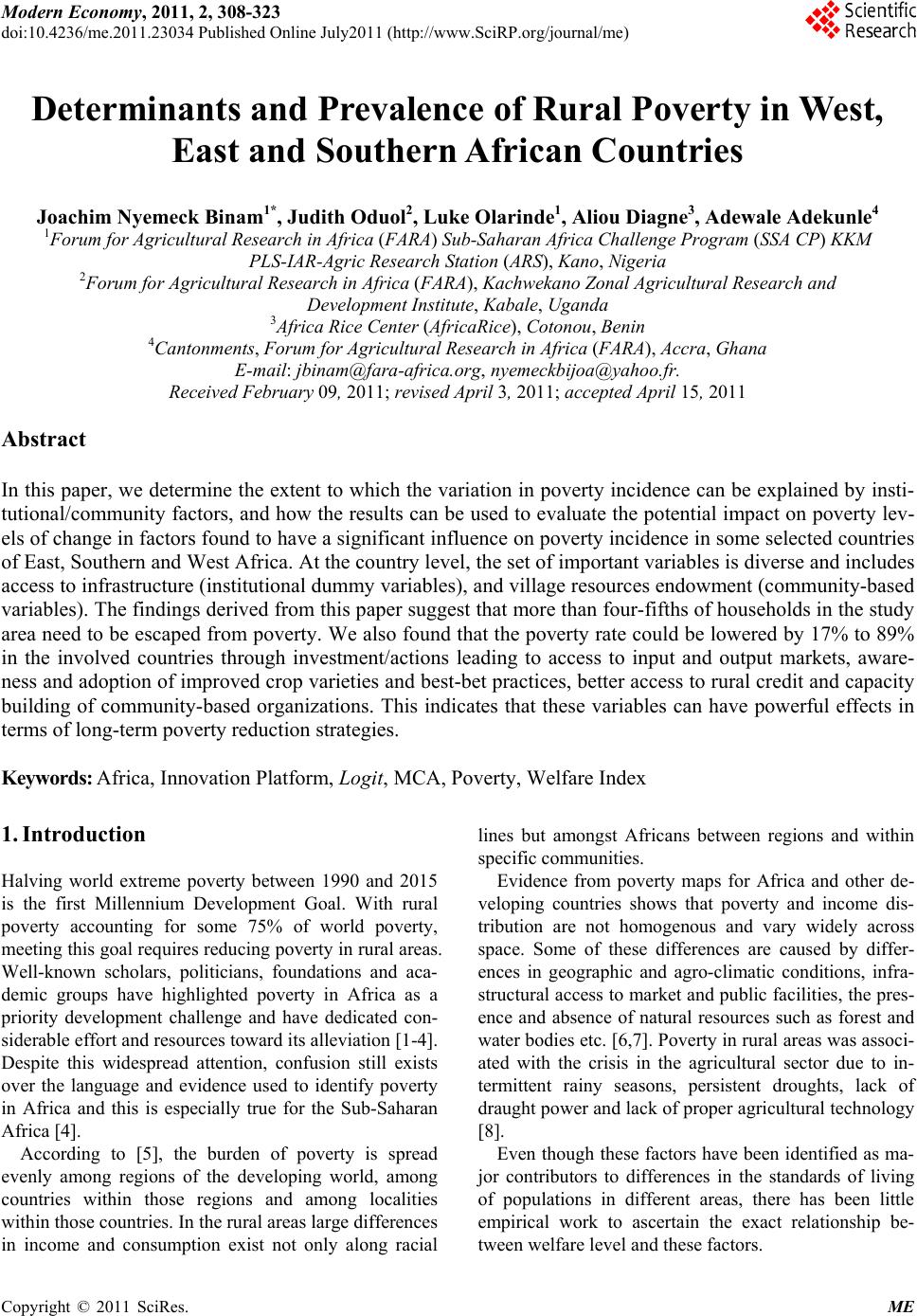 Modern Economy, 2011, 2, 308-323 doi:10.4236/me.2011.23034 Published Online July2011 (http://www.SciRP.org/journal/me) Copyright © 2011 SciRes. ME Determinants and Prevalence of Rural Poverty in West, East and Southern African Countries Joachim Nyemeck Binam1*, Judith Oduol2, Luke Olarinde1, Aliou Diagne3, Ad e w al e Adekunl e 4 1Forum for Agricultural Research in Africa (FARA) Sub-Saharan Africa Challenge Program (SSA CP) KKM PLS-IAR-Agric Research Station (ARS), Kano, Nigeria 2Forum for Agricultural Research in Africa (FARA), Kachwekano Zonal Agricultural Research and Development Institute, Kabale, Uganda 3Africa Rice Center (AfricaRice), Cotonou, Benin 4Cantonments, Forum for Agricultural Research in Africa (FARA), Accra, Ghana E-mail: jbinam@fara-africa.org, nyemeckbijoa@yahoo.fr. Received February 09, 2011; revised April 3, 2011; accepted April 15, 2011 Abstract In this paper, we determine the extent to which the variation in poverty incidence can be explained by insti- tutional/community factors, and how the results can be used to evaluate the potential impact on poverty lev- els of change in factors found to have a significant influence on poverty incidence in some selected countries of East, Southern and West Africa. At the country level, the set of important variables is diverse and includes access to infrastructure (institutional dummy variables), and village resources endowment (community-based variables). The findings derived from this paper suggest that more than four-fifths of households in the study area need to be escaped from poverty. We also found that the poverty rate could be lowered by 17% to 89% in the involved countries through investment/actions leading to access to input and output markets, aware- ness and adoption of improved crop varieties and best-bet practices, better access to rural credit and capacity building of community-based organizations. This indicates that these variables can have powerful effects in terms of long-term poverty reduction strategies. Keywords: Africa, Innovation Platform, Logit, MCA, Poverty, Welfare Index 1. Introduction Halving world extreme poverty between 1990 and 2015 is the first Millennium Development Goal. With rural poverty accounting for some 75% of world poverty, meeting this goal requires reducing poverty in rural areas. Well-known scholars, politicians, foundations and aca- demic groups have highlighted poverty in Africa as a priority development challenge and have dedicated con- siderable effort and resources toward its alleviation [1-4]. Despite this widespread attention, confusion still exists over the language and evidence used to identify poverty in Africa and this is especially true for the Sub-Saharan Africa [4]. According to [5], the burden of poverty is spread evenly among regions of the developing world, among countries within those regions and among localities within those countries. In the rural areas large differences in income and consumption exist not only along racial lines but amongst Africans between regions and within specific communities. Evidence from poverty maps for Africa and other de- veloping countries shows that poverty and income dis- tribution are not homogenous and vary widely across space. Some of these differences are caused by differ- ences in geographic and agro-climatic conditions, infra- structural access to market and public facilities, the pres- ence and absence of natural resources such as forest and water bodies etc. [6,7]. Poverty in rural areas was associ- ated with the crisis in the agricultural sector due to in- termittent rainy seasons, persistent droughts, lack of draught power and lack of proper agricultural technology [8]. Even though these factors have been identified as ma- jor contributors to differences in the standards of living of populations in different areas, there has been little empirical work to ascertain the exact relationship be- tween welfare level and these factors. 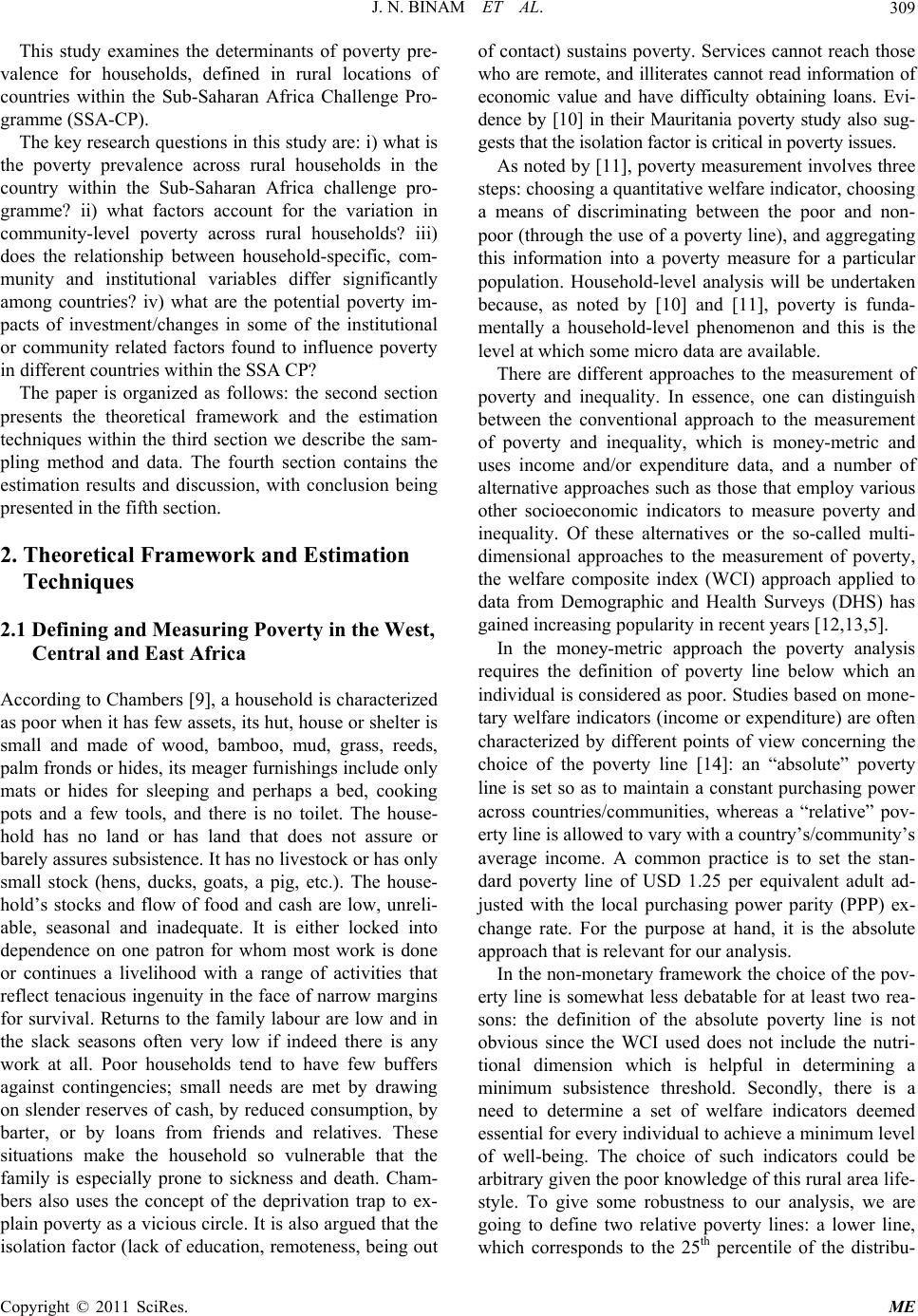 J. N. BINAM ET AL.309 This study examines the determinants of poverty pre- valence for households, defined in rural locations of countries within the Sub-Saharan Africa Challenge Pro- gramme (SSA-CP). The key research questions in this study are: i) what is the poverty prevalence across rural households in the country within the Sub-Saharan Africa challenge pro- gramme? ii) what factors account for the variation in community-level poverty across rural households? iii) does the relationship between household-specific, com- munity and institutional variables differ significantly among countries? iv) what are the potential poverty im- pacts of investment/changes in some of the institutional or community related factors found to influence poverty in different countries within the SSA CP? The paper is organized as follows: the second section presents the theoretical framework and the estimation techniques within the third section we describe the sam- pling method and data. The fourth section contains the estimation results and discussion, with conclusion being presented in the fifth section. 2. Theoretical Framework and Estimation Techniques 2.1 Defining and Measuring Poverty in the West, Central and East Africa According to Chambers [9], a household is characterized as poor when it has few assets, its hut, house or shelter is small and made of wood, bamboo, mud, grass, reeds, palm fronds or hides, its meager furnishings include only mats or hides for sleeping and perhaps a bed, cooking pots and a few tools, and there is no toilet. The house- hold has no land or has land that does not assure or barely assures subsistence. It has no livestock or has only small stock (hens, ducks, goats, a pig, etc.). The house- hold’s stocks and flow of food and cash are low, unreli- able, seasonal and inadequate. It is either locked into dependence on one patron for whom most work is done or continues a livelihood with a range of activities that reflect tenacious ingenuity in the face of narrow margins for survival. Returns to the family labour are low and in the slack seasons often very low if indeed there is any work at all. Poor households tend to have few buffers against contingencies; small needs are met by drawing on slender reserves of cash, by reduced consumption, by barter, or by loans from friends and relatives. These situations make the household so vulnerable that the family is especially prone to sickness and death. Cham- bers also uses the concept of the deprivation trap to ex- plain poverty as a vicious circle. It is also argued that the isolation factor (lack of education, remoteness, being out of contact) sustains poverty. Services cannot reach those who are remote, and illiterates cannot read information of economic value and have difficulty obtaining loans. Evi- dence by [10] in their Mauritania poverty study also sug- gests that the isolation factor is critical in poverty issues. As noted by [11], poverty measurement involves three steps: choosing a quantitative welfare indicator, choosing a means of discriminating between the poor and non- poor (through the use of a poverty line), and aggregating this information into a poverty measure for a particular population. Household-level analysis will be undertaken because, as noted by [10] and [11], poverty is funda- mentally a household-level phenomenon and this is the level at which some micro data are available. There are different approaches to the measurement of poverty and inequality. In essence, one can distinguish between the conventional approach to the measurement of poverty and inequality, which is money-metric and uses income and/or expenditure data, and a number of alternative approaches such as those that employ various other socioeconomic indicators to measure poverty and inequality. Of these alternatives or the so-called multi- dimensional approaches to the measurement of poverty, the welfare composite index (WCI) approach applied to data from Demographic and Health Surveys (DHS) has gained increasing popularity in recent years [12,13,5]. In the money-metric approach the poverty analysis requires the definition of poverty line below which an individual is considered as poor. Studies based on mone- tary welfare indicators (income or expenditure) are often characterized by different points of view concerning the choice of the poverty line [14]: an “absolute” poverty line is set so as to maintain a constant purchasing power across countries/communities, whereas a “relative” pov- erty line is allowed to vary with a country’s/community’s average income. A common practice is to set the stan- dard poverty line of USD 1.25 per equivalent adult ad- justed with the local purchasing power parity (PPP) ex- change rate. For the purpose at hand, it is the absolute approach that is relevant for our analysis. In the non-monetary framework the choice of the pov- erty line is somewhat less debatable for at least two rea- sons: the definition of the absolute poverty line is not obvious since the WCI used does not include the nutri- tional dimension which is helpful in determining a minimum subsistence threshold. Secondly, there is a need to determine a set of welfare indicators deemed essential for every individual to achieve a minimum level of well-being. The choice of such indicators could be arbitrary given the poor knowledge of this rural area life- style. To give some robustness to our analysis, we are going to define two relative poverty lines: a lower line, which corresponds to the 25th percentile of the distribu- Copyright © 2011 SciRes. ME 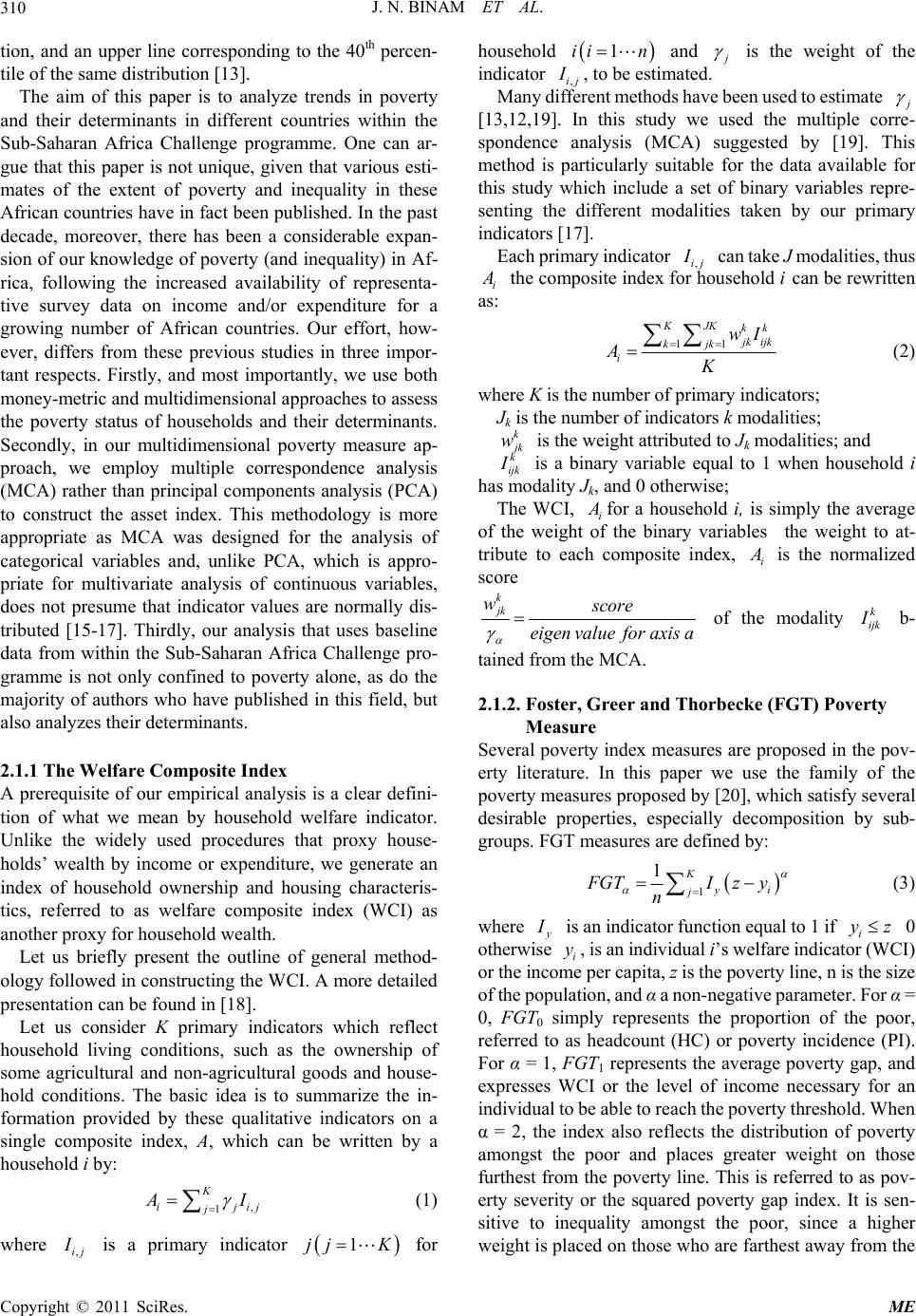 J. N. BINAM ET AL. 310 tion, and an upper line corresponding to the 40th percen- tile of the same distribution [13]. The aim of this paper is to analyze trends in poverty and their determinants in different countries within the Sub-Saharan Africa Challenge programme. One can ar- gue that this paper is not unique, given that various esti- mates of the extent of poverty and inequality in these African countries have in fact been published. In the past decade, moreover, there has been a considerable expan- sion of our knowledge of poverty (and inequality) in Af- rica, following the increased availability of representa- tive survey data on income and/or expenditure for a growing number of African countries. Our effort, how- ever, differs from these previous studies in three impor- tant respects. Firstly, and most importantly, we use both money-metric and multidimensional approaches to assess the poverty status of households and their determinants. Secondly, in our multidimensional poverty measure ap- proach, we employ multiple correspondence analysis (MCA) rather than principal components analysis (PCA) to construct the asset index. This methodology is more appropriate as MCA was designed for the analysis of categorical variables and, unlike PCA, which is appro- priate for multivariate analysis of continuous variables, does not presume that indicator values are normally dis- tributed [15-17]. Thirdly, our analysis that uses baseline data from within the Sub-Saharan Africa Challenge pro- gramme is not only confined to poverty alone, as do the majority of authors who have published in this field, but also analyzes their determinants. 2.1.1 The Welfare Composite Index A prerequisite of our empirical analysis is a clear defini- tion of what we mean by household welfare indicator. Unlike the widely used procedures that proxy house- holds’ wealth by income or expenditure, we generate an index of household ownership and housing characteris- tics, referred to as welfare composite index (WCI) as another proxy for household wealth. Let us briefly present the outline of general method- ology followed in constructing the WCI. A more detailed presentation can be found in [18]. Let us consider K primary indicators which reflect household living conditions, such as the ownership of some agricultural and non-agricultural goods and house- hold conditions. The basic idea is to summarize the in- formation provided by these qualitative indicators on a single composite index, A, which can be written by a household i by: , 1 K i jjij I (1) where is a primary indicator for household ,ij I 1jj K 1ii n and is the weight of the indicator , to be estimated. ,ij Many different methods have been used to estimate I [13,12,19]. In this study we used the multiple corre- spondence analysis (MCA) suggested by [19]. This method is particularly suitable for the data available for this study which include a set of binary variables repre- senting the different modalities taken by our primary indicators [17]. Each primary indicator ,ij can take J modalities, thus i the composite index for household i can be rewritten as: 11 KKJkk kijk wI kj k i A (2) where K is the number of primary indicators; Jk is the number of indicators k modalities; k k w k ijk is the weight attributed to Jk modalities; and is a binary variable equal to 1 when household i has modality Jk, and 0 otherwise; The WCI, i for a household i, is simply the average of the weight of the binary variables the weight to at- tribute to each composite index, i is the normalized score k jk wscore n value for axeigis a e of the modality k ijk b- tained from the MCA. 2.1.2. Foster, Greer and Thorbecke (FGT) Poverty Measure Several poverty index measures are proposed in the pov- erty literature. In this paper we use the family of the poverty measures proposed by [20], which satisfy several desirable properties, especially decomposition by sub- groups. FGT measures are defined by: 1 1K yi j GT y nI z (3) where I is an indicator function equal to 1 if i yz 0 otherwise i, is an individual i’s welfare indicator (WCI) or the income per capita, z is the poverty line, n is the size of the population, and α a non-negative parameter. For α = 0, FGT0 simply represents the proportion of the poor, referred to as headcount (HC) or poverty incidence (PI). For α = 1, FGT1 represents the average poverty gap, and expresses WCI or the level of income necessary for an individual to be able to reach the poverty threshold. When α = 2, the index also reflects the distribution of poverty amongst the poor and places greater weight on those furthest from the poverty line. This is referred to as pov- erty severity or the squared poverty gap index. It is sen- sitive to inequality amongst the poor, since a higher weight is placed on those who are farthest away from the y Copyright © 2011 SciRes. ME 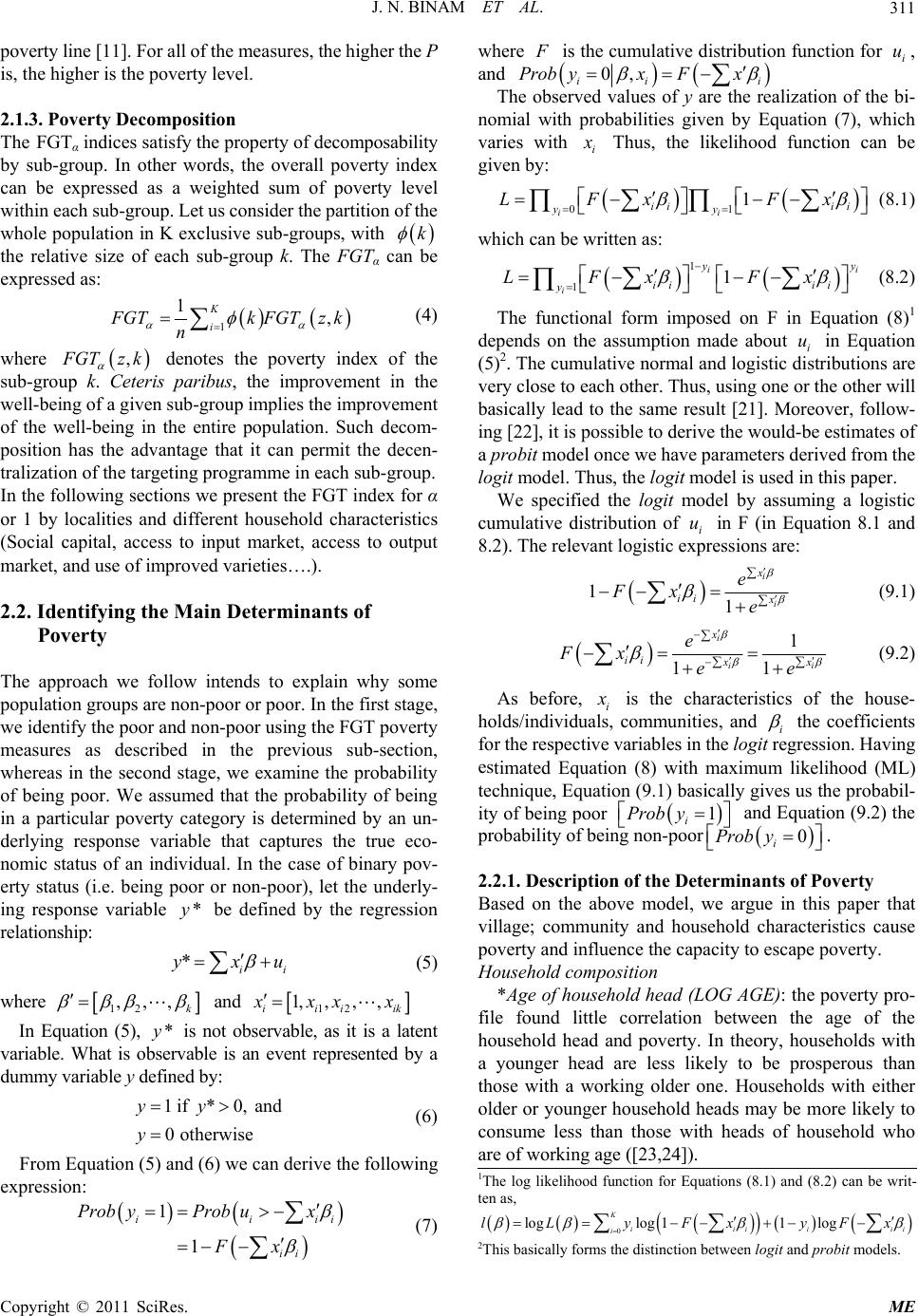 J. N. BINAM ET AL.311 poverty line [11]. For all of the measures, the higher the P is, the higher is the poverty level. 2.1.3. Po verty Decomposition The FGTα indices satisfy the property of decomposability by sub-group. In other words, the overall poverty index can be expressed as a weighted sum of poverty level within each sub-group. Let us consider the partition of the whole population in K exclusive sub-groups, with k the relative size of each sub-group k. The FGTα can be expressed as: 1 1, K i GTk FGTz k n (4) where , GTz k denotes the poverty index of the sub-group k. Ceteris paribus, the improvement in the well-being of a given sub-group implies the improvement of the well-being in the entire population. Such decom- position has the advantage that it can permit the decen- tralization of the targeting programme in each sub-group. In the following sections we present the FGT index for α or 1 by localities and different household characteristics (Social capital, access to input market, access to output market, and use of improved varieties….). 2.2. Identifying the Main Determinants of Poverty The approach we follow intends to explain why some population groups are non-poor or poor. In the first stage, we identify the poor and non-poor using the FGT poverty measures as described in the previous sub-section, whereas in the second stage, we examine the probability of being poor. We assumed that the probability of being in a particular poverty category is determined by an un- derlying response variable that captures the true eco- nomic status of an individual. In the case of binary pov- erty status (i.e. being poor or non-poor), let the underly- ing response variable be defined by the regression relationship: *y *ii yxu (5) where 12 ,,, k and 12 1,,, , iiiik xx x In Equation (5), * is not observable, as it is a latent variable. What is observable is an event represented by a dummy variable y defined by: 1 if *0, andyy 0 otherwise y (6) From Equation (5) and (6) we can derive the following expression: 1 1 iiii ii ProbyProb ux Fx (7) tion for i u, where is the cumulative distribution func and 0, ii i yx FxProb d values of y are the realization of the ic s with The observebi- nomial with probabilities given by Equation (7), whh varie i Thus, the likelihood function can be given by: 01 1 ii ii ii yy LFx Fx (8.1) which can be written as: 1 11 ii i y ii ii y LFx Fx (8.2) The functional form imposed on F in Equation (8)1 depends on the assumption made about in E (5)2. The cumulative normal and logistic distributions ar ve re i uquation e ry close to each other. Thus, using one or the other will basically lead to the same result [21]. Moover, follow- ing [22], it is possible to derive the would-be estimates of a probit model once we have parameters derived from the logit model. Thus, the logit model is used in this paper. We specified the logit model by assuming a logistic cumulative distribution of i u in F (in Equation 8.1 and 8.2). The relevant logistic expressions are: 11 i i x ii x e Fx e (9.1) 1 11 i ii x x ii x e Fx ee (9.2) ore, As befi is the characteristics of the house- holds/individuommunities, and als, ci the for the respectie variables in the logit ression. Having es coefficients v reg timated Equation (8) with maximum likelihood (ML) technique, Equation (9.1) basically gives us the probabil- ity of being poor 1 i Prob y and Equation (9.2) the probability of being non-poor 0 i Prob y . 2.2.1. Descriptioninants of Poverty Based on the above model, we of the Determ argue in this paper that village; community and household characteristics cause the erty. In theory, households with a poverty and influence the capacity to escape poverty. Household composition *Age of household head (LOG AGE): the poverty pro- file found little correlation between the age of household head and pov younger head are less likely to be prosperous than those with a working older one. Households with either older or younger household heads may be more likely to consume less than those with heads of household who are of working age ([23,24]). 1The log likelihood function for Equations (8.1) and (8.2) can be writ- ten as, 0 loglog 11log K iiii i lLyFx yFx ii 2This basically forms the distinction between logit and probit models. Copyright © 2011 SciRes. ME 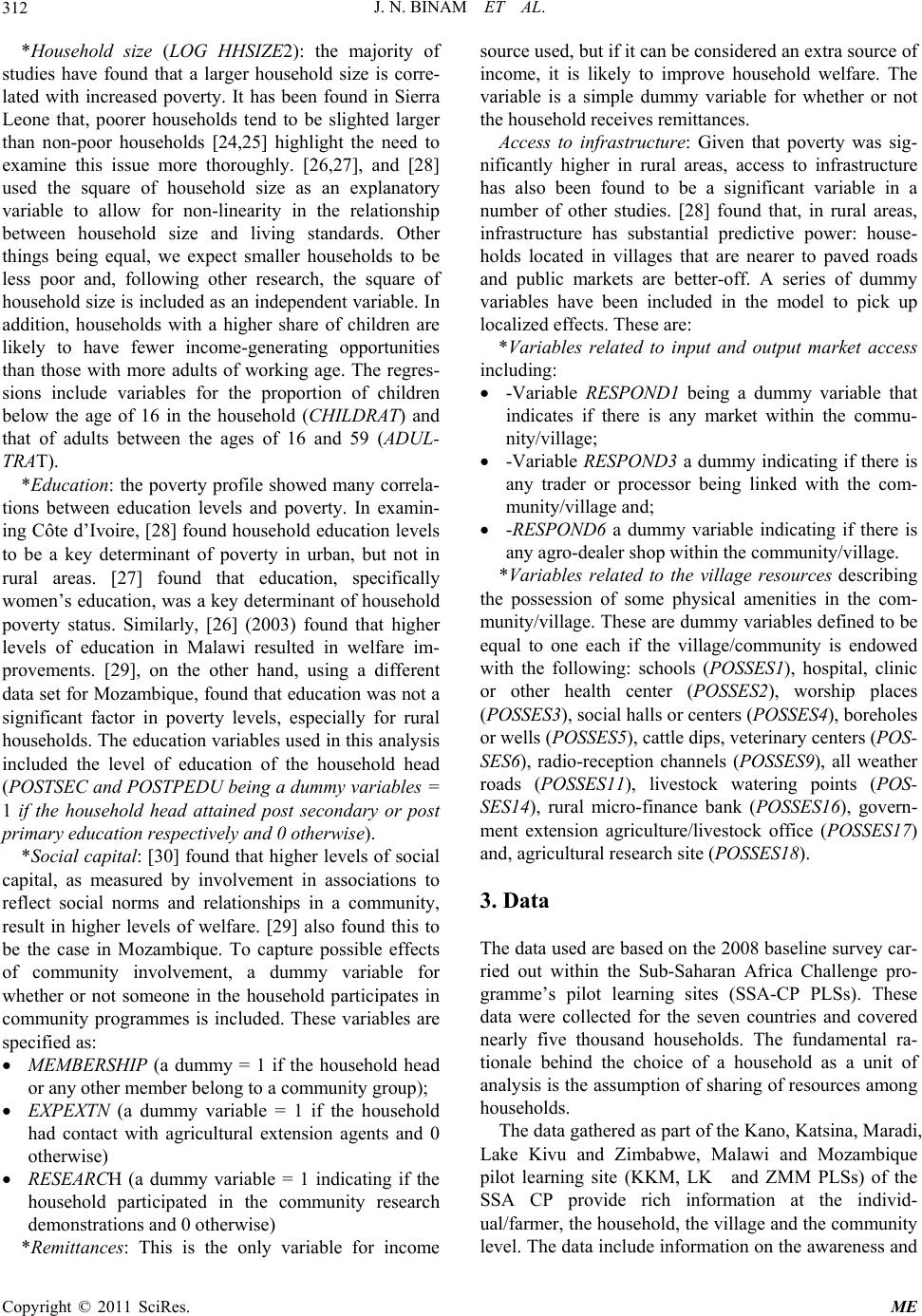 J. N. BINAM ET AL. 312 been found in Sierra Le d’Ivoire, [28] found household education lev to , re (a dummy variable = 1 if the household ons and 0 otherwise) sehold welfare. The va cant variable in a nu ing a dummy variable that age; e and; the village resources describing e eq The data used are based on the 2008 baseline survey car- ithin the Sub-Saharan Africa Challenge pro- gramme’s pilot learning sites (SSA-CP PLSs). These LK and ZMM PLSs) of the SS *Household size (LOG HHSIZE2): the majority of studies have found that a larger household size is corre- lated with increased poverty. It has one that, poorer households tend to be slighted larger than non-poor households [24,25] highlight the need to examine this issue more thoroughly. [26,27], and [28] used the square of household size as an explanatory variable to allow for non-linearity in the relationship between household size and living standards. Other things being equal, we expect smaller households to be less poor and, following other research, the square of household size is included as an independent variable. In addition, households with a higher share of children are likely to have fewer income-generating opportunities than those with more adults of working age. The regres- sions include variables for the proportion of children below the age of 16 in the household (CHILDRAT) and that of adults between the ages of 16 and 59 (ADUL- TRAT). *Education: the poverty profile showed many correla- tions between education levels and poverty. In examin- ing Côteels -RESPOND6 a dummy variable indicating if there is any agro-dealer shop within the community/village. *Variables related to be a key determinant of poverty in urban, but not in rural areas. [27] found that education, specifically women’s education, was a key determinant of household poverty status. Similarly, [26] (2003) found that higher levels of education in Malawi resulted in welfare im- provements. [29], on the other hand, using a different data set for Mozambique, found that education was not a significant factor in poverty levels, especially for rural households. The education variables used in this analysis included the level of education of the household head (POSTSEC and POSTPEDU being a dummy variables = 1 if the household head attained post secondary or post primary education respectively and 0 otherwise). *Social capital: [30] found that higher levels of social capital, as measured by involvement in associations to reflect social norms and relationships in a community sult in higher levels of welfare. [29] also found this to be the case in Mozambique. To capture possible effects of community involvement, a dummy variable for whether or not someone in the household participates in community programmes is included. These variables are specified as: MEMBERSHIP (a dummy = 1 if the household head or any other member belong to a community group); EXPEXTN had contact with agricultural extension agents and 0 otherwise) RESEARCH (a dummy variable = 1 indicating if the household participated in the community research demonstrati *Remittances: This is the only variable for income source used, but if it can be considered an extra source of income, it is likely to improve hou riable is a simple dummy variable for whether or not the household receives remittances. Access to infrastructure: Given that poverty was sig- nificantly higher in rural areas, access to infrastructure has also been found to be a signifi mber of other studies. [28] found that, in rural areas, infrastructure has substantial predictive power: house- holds located in villages that are nearer to paved roads and public markets are better-off. A series of dummy variables have been included in the model to pick up localized effects. These are: *Variables related to input and output market access including: -Variable RESPOND1 be indicates if there is any market within the commu- nity/vill -Variable RESPOND3 a dummy indicating if there is any trader or processor being linked with the com- munity/villag the possession of some physical amenities in the com- munity/village. These are dummy variables defined to b ual to one each if the village/community is endowed with the following: schools (POSSES1), hospital, clinic or other health center (POSSES2), worship places (POSSES3), social halls or centers (POSSES4), boreholes or wells (POSSES5), cattle dips, veterinary centers (POS- SES6), radio-reception channels (POSSES9), all weather roads (POSSES11), livestock watering points (POS- SES14), rural micro-finance bank (POSSES16), govern- ment extension agriculture/livestock office (POSSES17) and, agricultural research site (POSSES18). 3. Data ried out w data were collected for the seven countries and covered nearly five thousand households. The fundamental ra- tionale behind the choice of a household as a unit of analysis is the assumption of sharing of resources among households. The data gathered as part of the Kano, Katsina, Maradi, Lake Kivu and Zimbabwe, Malawi and Mozambique pilot learning site (KKM, A CP provide rich information at the individ- ual/farmer, the household, the village and the community level. The data include information on the awareness and Copyright © 2011 SciRes. ME 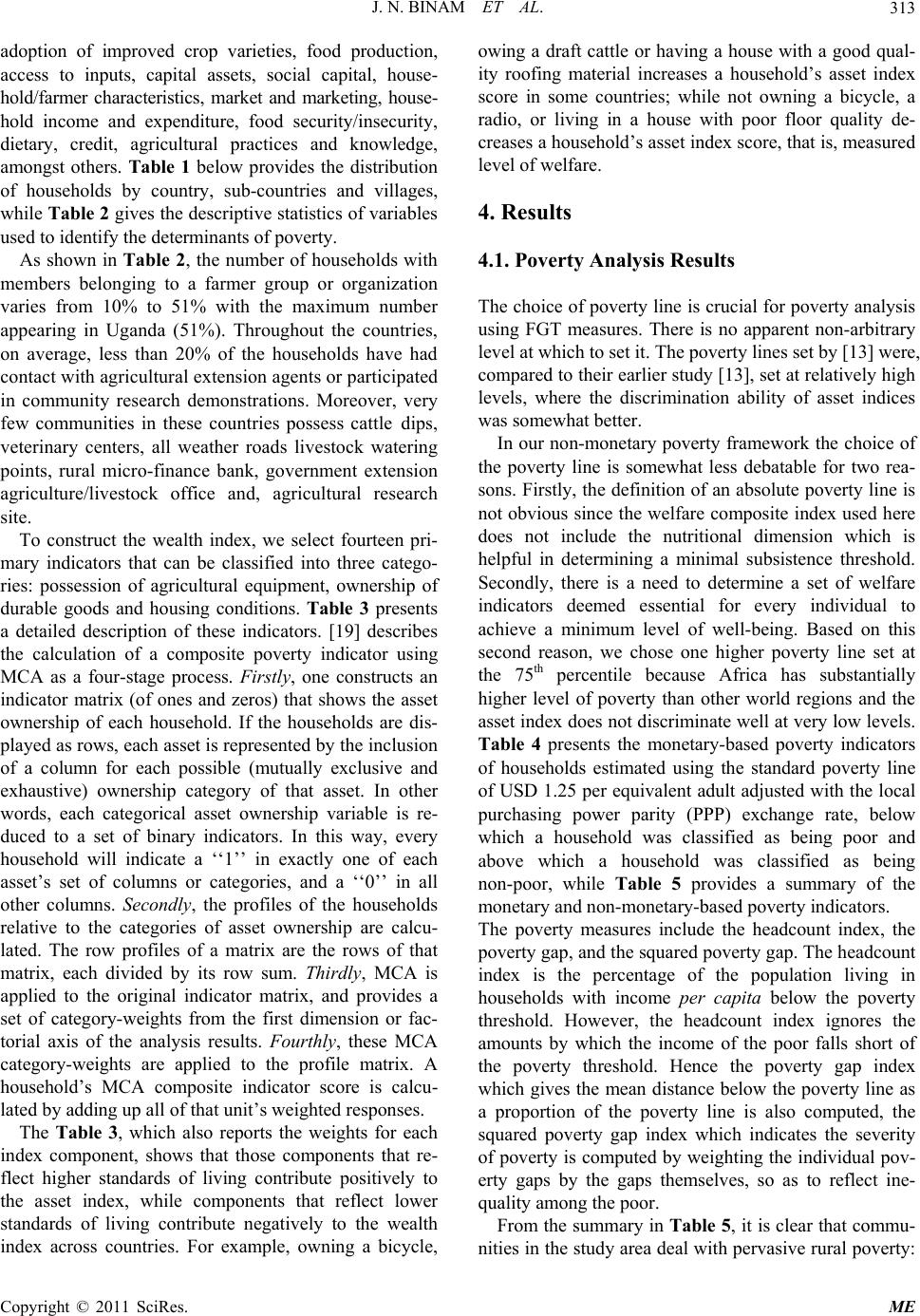 J. N. BINAM ET AL.313 um number ap possession of agricultural equipment, ownership of du th 4.1. Poverty Analysis Results The choice of poverty line is crucial for poverty analysis apparent non-arbitrary level at which to set it. The poverty lines set by [13] were, ion of an absolute poverty line is no in adoption of improved crop varieties, food production, access to inputs, capital assets, social capital, house- hold/farmer characteristics, market and marketing, house- hold income and expenditure, food security/insecurity, dietary, credit, agricultural practices and knowledge, amongst others. Table 1 below provides the distribution of households by country, sub-countries and villages, while Table 2 gives the descriptive statistics of variables used to identify the determinants of poverty. As shown in Table 2, the number of households with members belonging to a farmer group or organization varies from 10% to 51% with the maxim pearing in Uganda (51%). Throughout the countries, on average, less than 20% of the households have had contact with agricultural extension agents or participated in community research demonstrations. Moreover, very few communities in these countries possess cattle dips, veterinary centers, all weather roads livestock watering points, rural micro-finance bank, government extension agriculture/livestock office and, agricultural research site. To construct the wealth index, we select fourteen pri- mary indicators that can be classified into three catego- ries: rable goods and housing conditions. Table 3 presents a detailed description of these indicators. [19] describes the calculation of a composite poverty indicator using MCA as a four-stage process. Firstly, one constructs an indicator matrix (of ones and zeros) that shows the asset ownership of each household. If the households are dis- played as rows, each asset is represented by the inclusion of a column for each possible (mutually exclusive and exhaustive) ownership category of that asset. In other words, each categorical asset ownership variable is re- duced to a set of binary indicators. In this way, every household will indicate a ‘‘1’’ in exactly one of each asset’s set of columns or categories, and a ‘‘0’’ in all other columns. Secondly, the profiles of the households relative to the categories of asset ownership are calcu- lated. The row profiles of a matrix are the rows of that matrix, each divided by its row sum. Thirdly, MCA is applied to the original indicator matrix, and provides a set of category-weights from the first dimension or fac- torial axis of the analysis results. Fourthly, these MCA category-weights are applied to the profile matrix. A household’s MCA composite indicator score is calcu- lated by adding up all of that unit’s weighted responses. The Table 3, which also reports the weights for each index component, shows that those components that re- flect higher standards of living contribute positively to e asset index, while components that reflect lower standards of living contribute negatively to the wealth index across countries. For example, owning a bicycle, owing a draft cattle or having a house with a good qual- ity roofing material increases a household’s asset index score in some countries; while not owning a bicycle, a radio, or living in a house with poor floor quality de- creases a household’s asset index score, that is, measured level of welfare. 4. Results using FGT measures. There is no compared to their earlier study [13], set at relatively high levels, where the discrimination ability of asset indices was somewhat better. In our non-monetary poverty framework the choice of the poverty line is somewhat less debatable for two rea- sons. Firstly, the definit t obvious since the welfare composite index used here does not include the nutritional dimension which is helpful in determining a minimal subsistence threshold. Secondly, there is a need to determine a set of welfare indicators deemed essential for every individual to achieve a minimum level of well-being. Based on this second reason, we chose one higher poverty line set at the 75th percentile because Africa has substantially higher level of poverty than other world regions and the asset index does not discriminate well at very low levels. Table 4 presents the monetary-based poverty indicators of households estimated using the standard poverty line of USD 1.25 per equivalent adult adjusted with the local purchasing power parity (PPP) exchange rate, below which a household was classified as being poor and above which a household was classified as being non-poor, while Table 5 provides a summary of the monetary and non-monetary-based poverty indicators. The poverty measures include the headcount index, the poverty gap, and the squared poverty gap. The headcount index is the percentage of the population living households with income per capita below the poverty threshold. However, the headcount index ignores the amounts by which the income of the poor falls short of the poverty threshold. Hence the poverty gap index which gives the mean distance below the poverty line as a proportion of the poverty line is also computed, the squared poverty gap index which indicates the severity of poverty is computed by weighting the individual pov- erty gaps by the gaps themselves, so as to reflect ine- quality among the poor. From the summary in Table 5, it is clear that commu- nities in the study area deal with pervasive rural poverty: Copyright © 2011 SciRes. ME 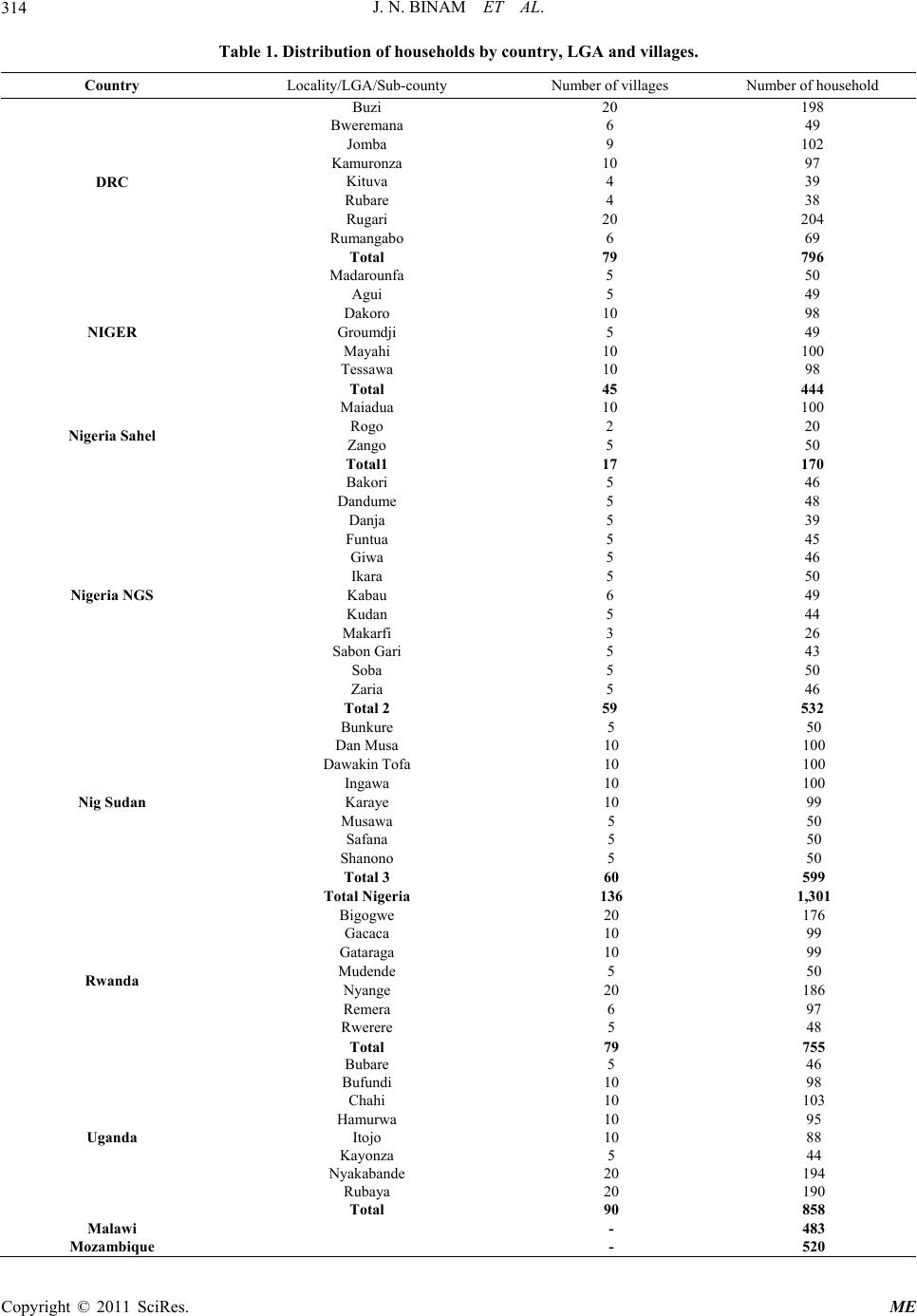 J. N. BINAM ET AL. Copyright © 2011 SciRes. ME 314 Table 1. Distribution of households Number of household bycountry, LGA and villages. Country Locality/LGA/Sub-county Number of villages Buzi 20 198 Bweremana 6 49 Jomba 9 102 Kamuronza 10 97 Kituva 4 39 Rubare 4 38 Rugari 20 204 Ro DRC NIGER Nigeria Sahel D Sabon Gari Nigeria NGS B D D Nig Sudan Toa 1, Rwanda N Uganda Malawi Mozambique umangab6 69 Total 79 796 Madarounfa 5 50 Agui 5 49 Dakoro Gri 10 98 oumdj5 49 Mayahi 10 100 Tessawa 10 98 Total 45 444 Maiadua 10 100 Rogo 2 20 Zango 5 50 Total1 17 170 Bakori 5 46 andume 5 48 Danja 5 39 Funtua 5 45 Giwa 5 46 Ikara 5 50 Kabau 6 49 Kudan 5 44 Makarfi 3 26 5 43 Soba 5 50 Zaria T5 46 otal 2 59 532 unkure 5 50 an Musa 10 100 awakin Tofa 10 100 Ingawa 10 100 Karaye 10 99 Musawa 5 50 Safana 5 50 Shanono 5 50 Total 3 60 599 tal Nigeri136 301 Bigogwe 20 176 Gacaca 10 99 Gataraga 10 99 Mudende 5 50 Nyange 20 186 Remera 6 97 Rwerere 5 48 Total 79 755 Bubare B 5 46 ufundi 10 98 1 Chahi 1003 Hamurwa 10 95 Itojo 10 88 Kayonza ya de 5 44 kaban20 194 Rubaya 20190 Total 90 858 - - 483 520 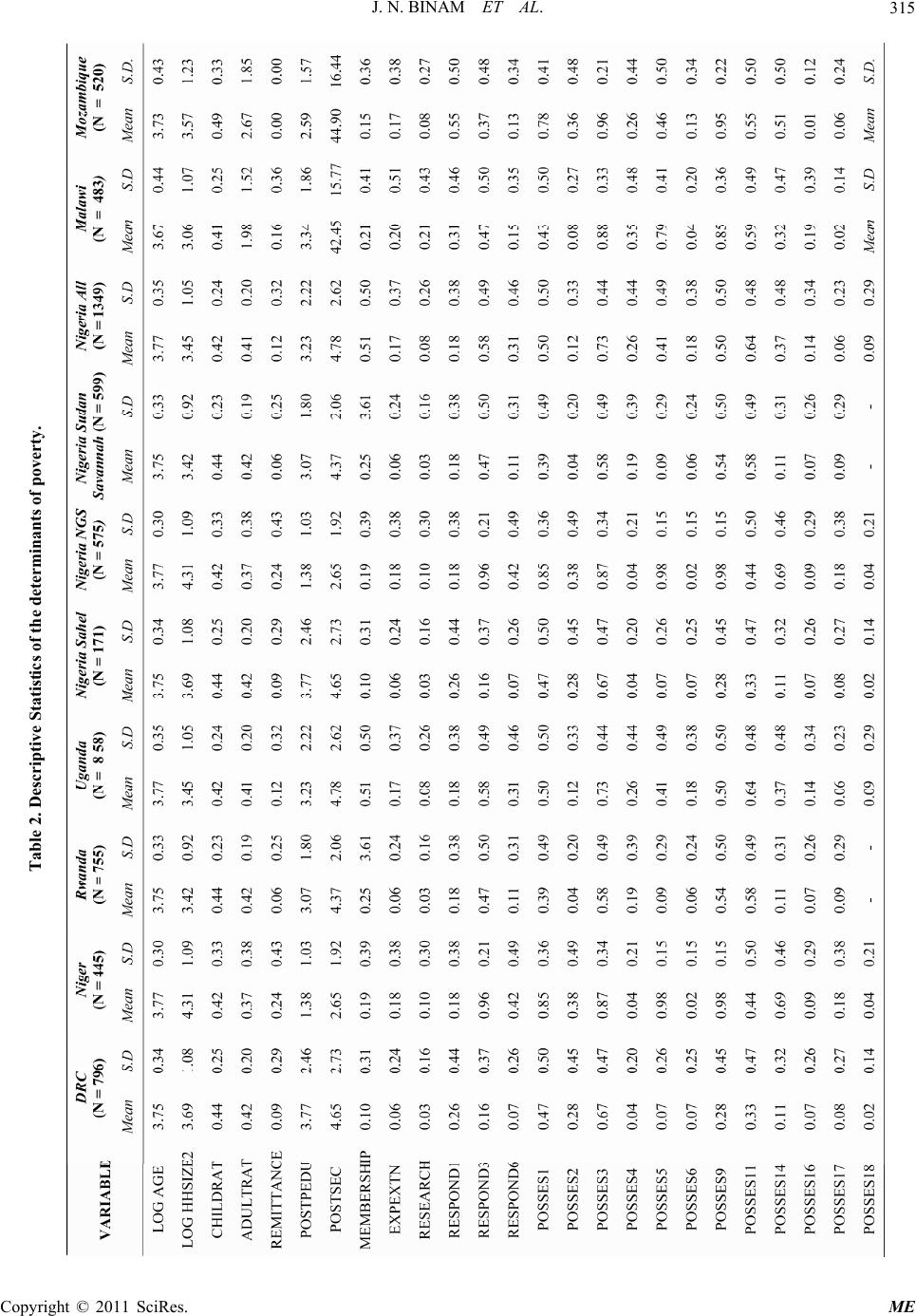 J. N. BINAM ET AL.315 Table 2. Descriptive Statistics of the determinants of poverty. Copyright © 2011 SciRes. ME 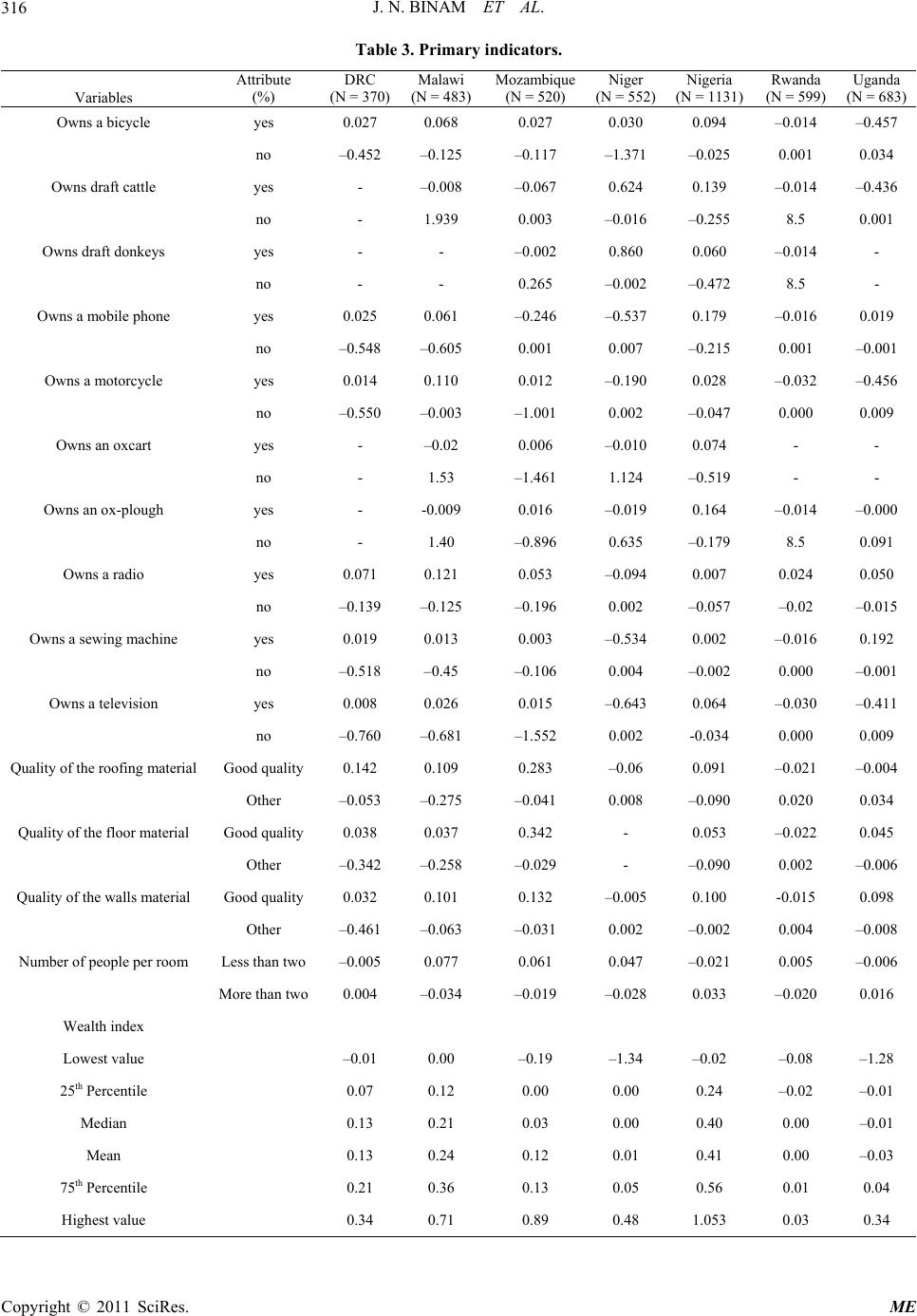 J. N. BINAM ET AL. 316 Table 3. Primary indicators. Variables Attribute (%) DRC (N = 370) Malawi (N = 483) Mozambique (N = 520) Niger (N = 552) Nigeria (N = 1131) Rwanda (N = 599) Uganda (N = 683) Owns a bicycle yes 0.027 0.068 0.027 0.030 0.094 –0.014 –0.457 no –0.452 –0.125 –0.117 –1.371 –0.025 0.001 0.034 Owns draft cattle yes - –0.008 –0.067 0.624 0.139 –0.014 –0.436 no - 1.939 0.003 –0.016 –0.255 8.5 0.001 Owns draft donkeys yes - - –0.002 0.860 0.060 –0.014 - no - - 0.265 –0.002 –0.472 8.5 - Owns a mobile phone yes 0.025 0.061 –0.246 –0.537 0.179 –0.016 0.019 no –0.548 –0.605 0.001 0.007 –0.215 0.001 –0.001 Owns a motorcycle yes 0.014 0.110 0.012 –0.190 0.028 –0.032 –0.456 no –0.550 –0.003 –1.001 0.002 –0.047 0.000 0.009 Owns an oxcart yes - –0.02 0.006 –0.010 0.074 - - no - 1.53 –1.461 1.124 –0.519 - - plough yes - -0.009 0.016 –0.019 0.164 –0.014 –0.000 no - 1.40 –0.896 0.635 –0.179 8.5 0.091 Owns a radio yes 0.071 0.121 0.053 –0.094 0.007 0.024 0.050 no –0.139 –0.125 –0.196 0.002 –0.057 –0.02 –0.015 ns a sewing machine yes 0.019 0.013 0.003 –0.534 0.002 –0.016 0.192 no –0.518 –0.45 –0.106 0.004 –0.002 0.000 –0.001 yes 0.008 0.026 0.015 –0.643 0.064 –0.030 –0.411 no –0.760 –0.681 –1.552 0.002 -0.034 0.000 0.009 Quality of the roofing material Good quality 0.142 0.109 0.283 –0.06 0.091 –0.021 –0.004 Other –0.053 –0.275 –0.041 0.008 –0.090 0.020 0.034 of the floor material Good quality 0.038 0.037 0.342 - 0.053 –0.022 0.045 Other –0.342 –0.258 –0.029 - –0.090 0.002 –0.006 Quality of the walls material Good quality 0.032 0.101 0.132 –0.005 0.100 -0.015 0.098 Other –0.461 –0.063 –0.031 0.002 –0.002 0.004 –0.008 Number of people per room Less than two –0.005 0.077 0.061 0.047 –0.021 0.005 –0.006 More than two 0.004 –0.034 –0.019 –0.028 0.033 –0.020 0.016 Wealth index Lowest value –0.01 0.00 –0.19 –1.34 –0.02 –0.08 –1.28 25th Percentile 0.07 0.12 0.00 0.00 0.24 –0.02 –0.01 Median 0.13 0.21 0.03 0.00 0.40 0.00 –0.01 Mean 0.13 0.24 0.12 0.01 0.41 0.00 –0.03 75th Percentile 0.21 0.36 0.13 0.05 0.56 0.01 0.04 Highest value 0.34 0.71 0.89 0.48 1.053 0.03 0.34 Owns an ox- Ow Owns a television Quality Copyright © 2011 SciRes. ME 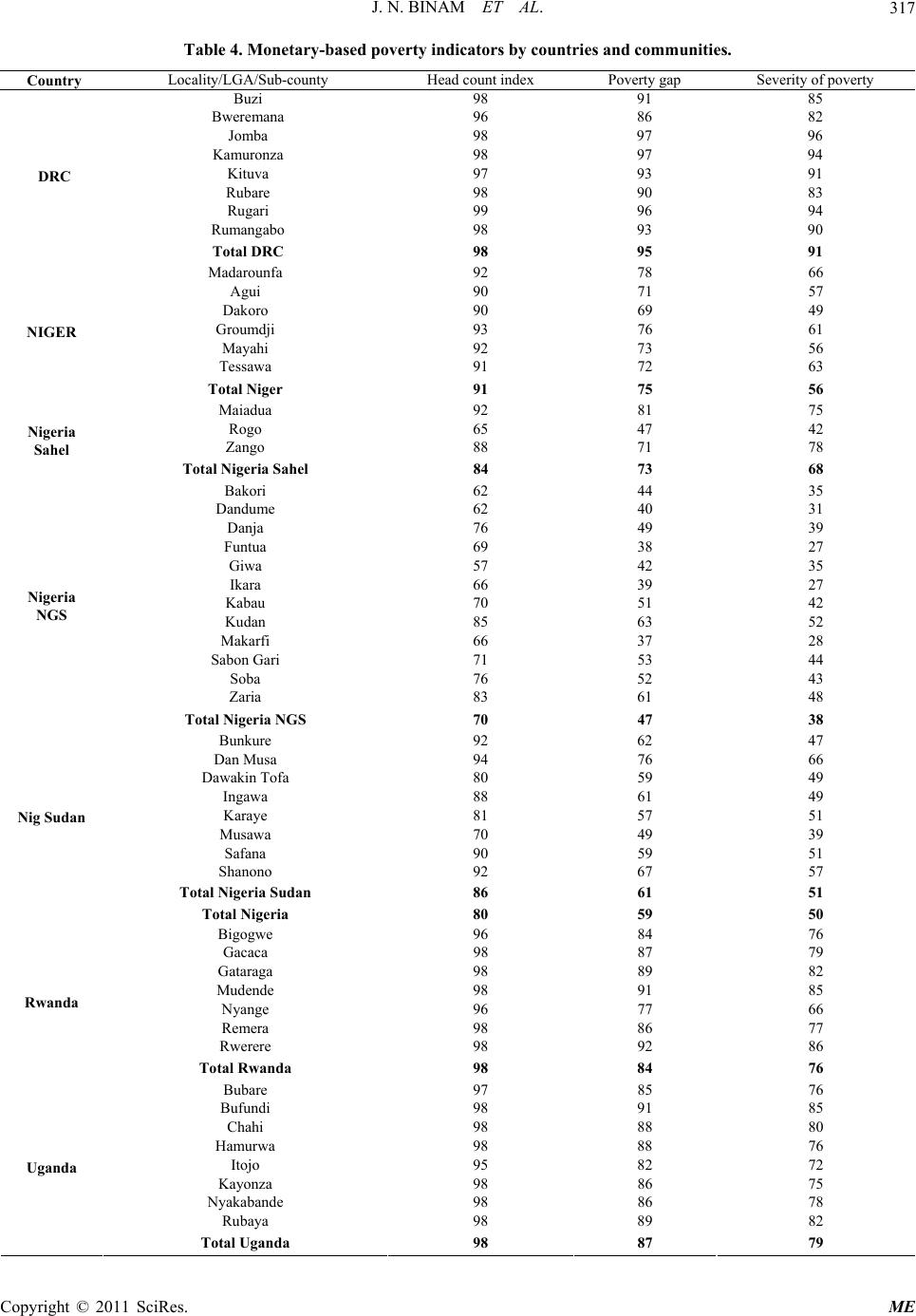 J. N. BINAM ET AL.317 Table 4. Monetary-basries and communities. Country Locality/Lunty unS ov ed poverty indicators by count GA/Sub-coHead cot index Poverty gap everity of perty Bu8 zi 991 85 Bwere 96 Jom Kamua 98 Kituva 97 Rub98 Rug99 Rumangabo 98 90 DRC Total DRC 98 Madarounfa 92 66 Ag90 Dak90 Groum May92 Tessawa 91 NIGER Total Niger 91 Maiadua 92 Rogo 65 47 42 Zan88 78 Nigeria Sa Total Nigeria Sahel 84 68 Bakor35 Dand Danja 76 39 Fun69 Giw57 Ikar66 Kab70 Kudan 85 63 52 Mak66 Sabon Gari 71 Sob76 Zar83 Nigeria NGS Total Nigeria NGS 70 47 38 Bunk92 D94 a80 Ing88 Karaye 81 57 51 70 49 Safana 90 59 Shanono 92 67 Nig Sudan tal Nigeria Sudan 86 Total Nigeria 80 59 50 Bigogwe 96 98 98 98 Nyange 96 77 66 Reme86 77 Rwerere 98 Rwanda Total Rwanda 98 Bubar5 Bufundi 98 91 85 Chah98 8 0 Hamurwa 98 8 6 Itojo 95 2 2 Kayonza 98 6 5 Nyakabande 98 Rubay 2 Uganda Total Uganda 98 87 79 mana ba 98 86 97 82 96 ronz97 94 93 90 91 83are ari 96 93 94 9591 78 71ui 57 oro dji 93 69 76 49 61 ahi 7356 72 75 63 56 81 75 go 71 hel 73 44 i 62 ume 62 4031 49 38tua 27 a a 42 39 35 27 au 5142 arfi 3728 53 52 44 43a ia 6148 ure 6247 an Musa wakin Tofa 76 59 66 49 D awa 6149 Musawa 39 51 57 To 61 51 84 76 Gacaca Gataraga 87 89 79 82 Mudende 9185 ra 98 92 84 86 76 e 97 876 i 88 8 8 7 7 8 7 86 89 78 8a 98 Copyright © 2011 SciRes. ME 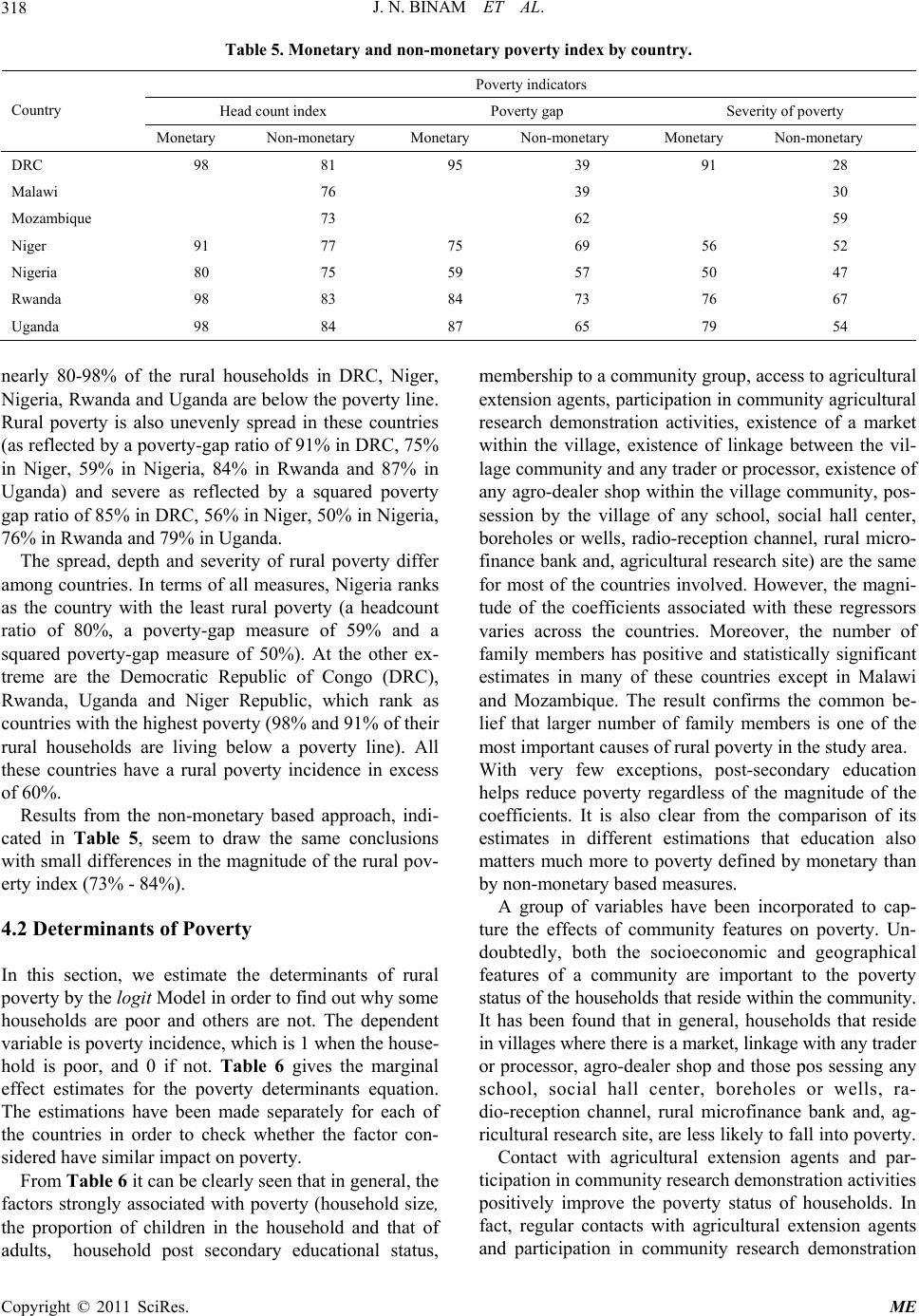 J. N. BINAM ET AL. Copyright © 2011 SciRes. ME 318 icators Table 5. Monetary and non-monetary pove rty index by country. Poverty ind Head count index ty gap Severity of pty Poverover Country Monetary Non-monetary Monetary Non-monetary Monetary Non-etary mon DRC 98 81 95 39 91 28 Malawi 76 39 30 Mozambique 73 62 59 Niger 91 77 75 69 56 52 Nigeria 80 75 59 57 50 47 Rwanda 98 83 84 73 76 67 Uganda 98 84 87 65 79 54 nearly 80-98% of the ruran DRC, Niger, Nigeria, Rwanda and Uganw the poverty line. Rurty is also unevenad in these countries (as d by a poverty-gapof 91% in DRC, 75% in Niger, 59% in Nigeda and 87% in Uganda) and severe as refly a squared poverty gap ratio of 85% in DRC, 5er, 50% in Nigeria, 76% in Rwanda and 79% in . The spread, depth and sevf rural poverty differ amongntries. In terms of easures, Nigeria ranks as the country with the leastpoverty (a headcount ratio o80%, a poverty-gasure of 59% and a squared poverty-gap meas). At the other ex- treme are the Democratic Rlic of Congo (DRC), Rwanda, Uganda and Nigerblic, which rank as countries with the highend 91% of their rural households are livinga poverty line). All these countries have a rucidence in excess of 60%. om the non-monased approach, indi- cated in Table 5, seem to e same conclusions with small differences in theude of the rural pov- erty index (73% - 84%) 4.2 Determinants of Po In this section, we estimaterminants of rural po logit Model find out why some households are poor and ot not. The dependent variable is poverty incidence1 when the house- hold is poor, and 0 if noives the marginal effect estimates for the povterminants equation. The estimations have been parately for each of the countries in order to chther the factor con- side similar impact . From ble 6 it can be clearly seen that in general, the factors strongly associatedty (household size, the proportion of children iousehold and that of adults, household post ducational status, mbership to a com accessgricultural tension agents, participation in community agricultural earch demonstration activities, existence of a market thin the village, existence of linkage between the vil- e community and trader or processoxistence of y agro-dealer shop within the village community, pos- sion by the villagny school, social hall center, reholes or wells, ro-reception channel, rural micro- ance bank and, agltural research site) are the same ost of the countries involved. Howevagni- e of the coefficients associated with th regressors ries across the ctries. Moreover, the number of ily members has positive and statistically significant imates in many oese countries excin Malawi d Mozambique. The result confirms the common be- f that larger numbof family members is one of the st important causf rural poverty in thtudy area. ith very few extions, post-seconducation lps reduce povertygardless of the maude of the efficients. It is al from the comparison of its imates in different estimations that education also tters much more to poverty defined by etary than non-monetary basmeasures. A group of variables have been incorped to cap- e the effects of cmunity features onverty. Un- ubtedly, both the socioeconomic and geographical tures of a commty are important te poverty tus of the households that reside within the community. has been found thn general, househothat reside villages where there is a market, linkage with any trader processor, agro-dealer shop and those pos sessing any hool, social hall center, boreholes wells, ra- -reception channel, rural microfinance k and, ag- ultural research site, are less likely to fato poverty. Contact with agricultural extension agents and par- ipation in commun research demonstrn activities sitively improve tpoverty status of households. In t, regular contactith agricultural extension agents d participation inunity research onstration l da are belo households i ral pove reflecte ly spre ratio ria, 84% in Rwan ected b 6% in Nig Uganda erity o cou f all m rural p mea ure of 50% epub Repu st poverty (98% a below ral poverty in Results fretary b draw th magnit . verty te the de verty by thein order to hers are , which is t. Table 6 g erty de made se e e on erty ck wh ered hav Ta pov with pover n the h secondary e memunity group, to a ex res wi lag anyr, e an sese of a bo adi fin ricu for mer, the m tud ese va oun fam estf thept an lieer moes oe s Wcepary ed he regnit coso clear est ma mon byed orat tur om po do feaunio th sta It at ilds in or scor dio ban ric ll in tic ity atio pohe facs w an commdem 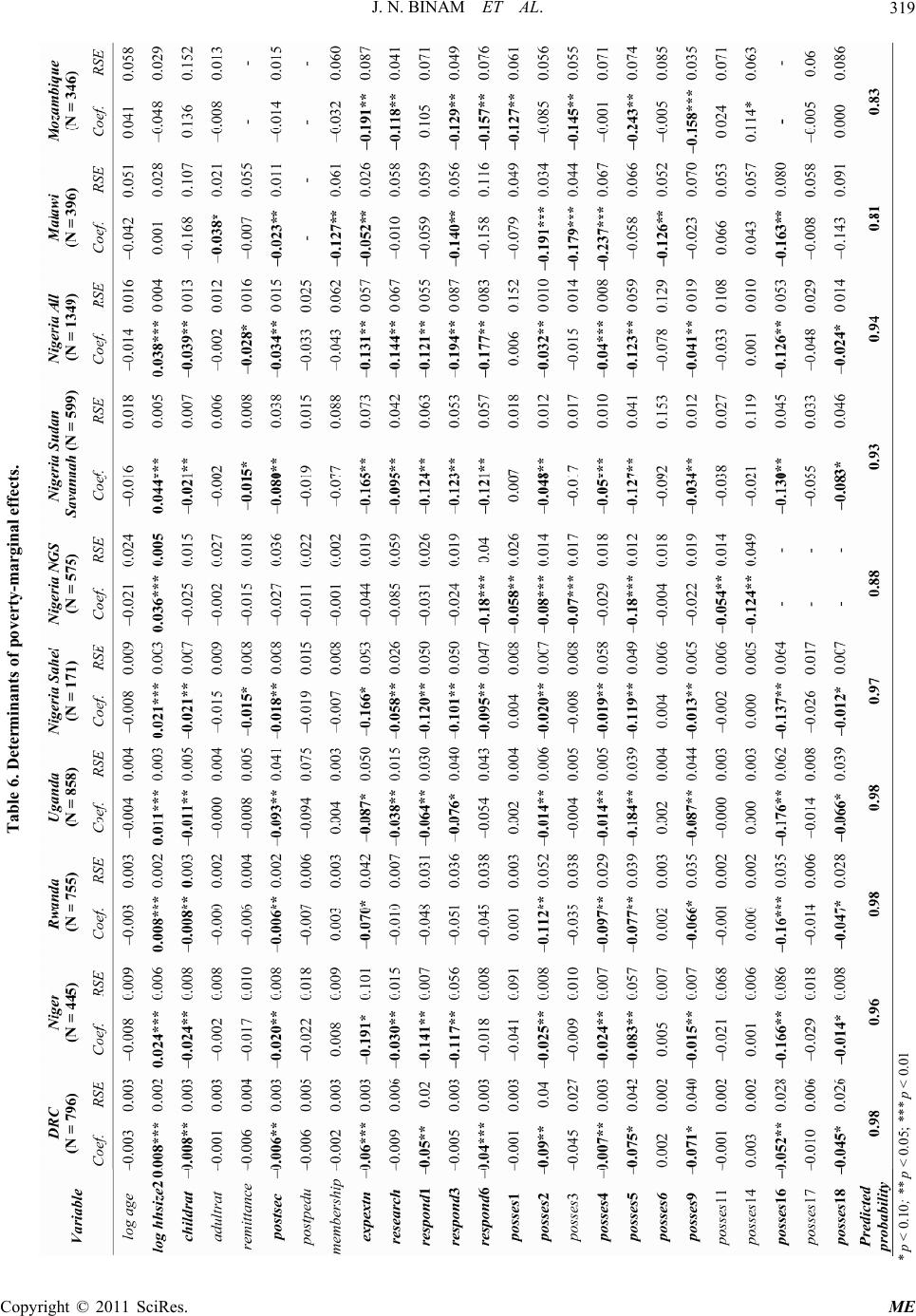 J. N. BINAM ET AL.319 * p < 0.10; ** p < 0. Table 6. Determinants of poverty-marginal effects. 05; *** p < 0.01 Copyright © 2011 SciRes. ME 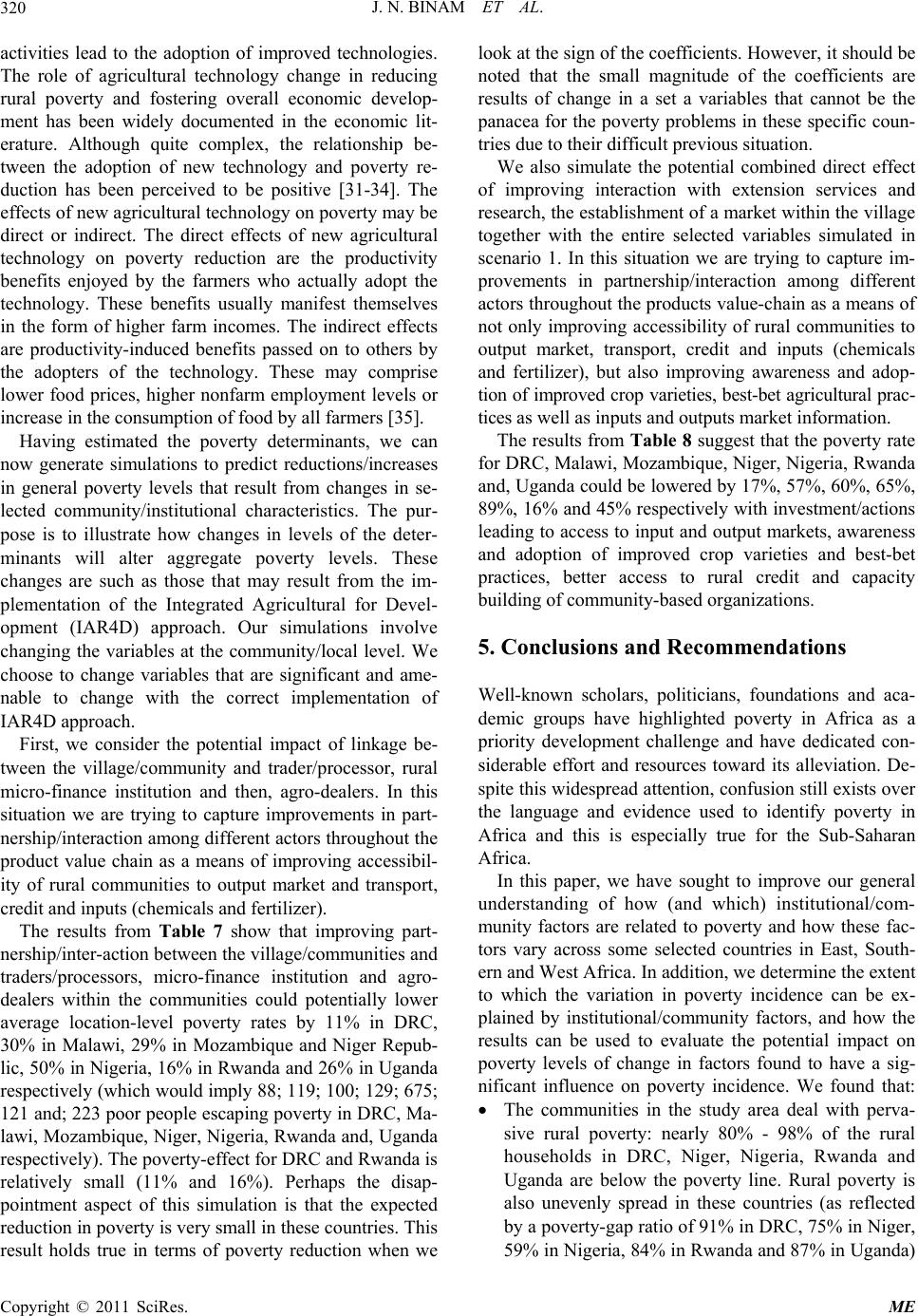 J. N. BINAM ET AL. 320 activities lead to the adoption of improved technologies. The role of agricultural technology change in reducing rural poverty and fostering overall economic develop- ment has been widely documented in the economic lit- erature. Although quite complex, the relationship be- tween the adoption of new technology and poverty re- duction has been perceived to be positive [31-34]. The effects of new agricultural technology on poverty may be direct or indirect. The direct effects of new agricultural technology on poverty reduction are the productivity benefits enjoyed by the farmers who actually adopt the technology. These benefits usually manifest themselves in the form of higher farm incomes. The indirect effects are productivity-induced benefits passed on to others by the adopters of the technology. These may comprise lower food prices, higher nonfarm employment levels or increase in the consumption of food by all farmers [35]. Having estimated the poverty determinants, we can now generate simulations to predict reductions/increases in general poverty levels that result from changes in se- lected community/institutional characteristics. The pur- pose is to illustrate how changes in levels of the deter- minants will alter aggregate poverty levels. These changes are such as those that may result from the im- plementation of the Integrated Agricultural for Devel- opment (IAR4D) approach. Our simulations involve changing the variables at the community/local level. We choose to change variables that are significant and ame- nable to change with the correct implementation of IAR4D approach. First, we consider the potential impact of linkage be- tween the village/community and trader/processor, rural micro-finance institution and then, agro-dealers. In this situation we are trying to capture improvements in part- nership/interaction among different actors throughout the product value chain as a means of improving accessibil- ity of rural communities to output market and transport, credit and inputs (chemicals and fertilizer). The results from Table 7 show that improving part- nership/inter-action between the village/communities and traders/processors, micro-finance institution and agro- dealers within the communities could potentially lower average location-level poverty rates by 11% in DRC, 30% in Malawi, 29% in Mozambique and Niger Repub- lic, 50% in Nigeria, 16% in Rwanda and 26% in Uganda respectively (which would imply 88; 119; 100; 129; 675; 121 and; 223 poor people escaping poverty in DRC, Ma- lawi, Mozambique, Niger, Nigeria, Rwanda and, Uganda respectively). The poverty-effect for DRC and Rwanda is relatively small (11% and 16%). Perhaps the disap- pointment aspect of this simulation is that the expected reduction in poverty is very small in these countries. This result holds true in terms of poverty reduction when we look at the sign of the coefficients. However, it should be noted that the small magnitude of the coefficients are results of change in a set a variables that cannot be the panacea for the poverty problems in these specific coun- tries due to their difficult previous situation. We also simulate the potential combined direct effect of improving interaction with extension services and research, the establishment of a market within the village together with the entire selected variables simulated in scenario 1. In this situation we are trying to capture im- provements in partnership/interaction among different actors throughout the products value-chain as a means of not only improving accessibility of rural communities to output market, transport, credit and inputs (chemicals and fertilizer), but also improving awareness and adop- tion of improved crop varieties, best-bet agricultural prac- tices as well as inputs and outputs market information. The results from Table 8 suggest that the poverty rate for DRC, Malawi, Mozambique, Niger, Nigeria, Rwanda and, Uganda could be lowered by 17%, 57%, 60%, 65%, 89%, 16% and 45% respectively with investment/actions leading to access to input and output markets, awareness and adoption of improved crop varieties and best-bet practices, better access to rural credit and capacity building of community-based organizations. 5. Conclusions and Recommendations Well-known scholars, politicians, foundations and aca- demic groups have highlighted poverty in Africa as a priority development challenge and have dedicated con- siderable effort and resources toward its alleviation. De- spite this widespread attention, confusion still exists over the language and evidence used to identify poverty in Africa and this is especially true for the Sub-Saharan Africa. In this paper, we have sought to improve our general understanding of how (and which) institutional/com- munity factors are related to poverty and how these fac- tors vary across some selected countries in East, South- ern and West Africa. In addition, we determine the extent to which the variation in poverty incidence can be ex- plained by institutional/community factors, and how the results can be used to evaluate the potential impact on poverty levels of change in factors found to have a sig- nificant influence on poverty incidence. We found that: The communities in the study area deal with perva- sive rural poverty: nearly 80% - 98% of the rural households in DRC, Niger, Nigeria, Rwanda and Uganda are below the poverty line. Rural poverty is also unevenly spread in these countries (as reflected by a poverty-gap ratio of 91% in DRC, 75% in Niger, 59% in Nigeria, 84% in Rwanda and 87% in Ugana) d Copyright © 2011 SciRes. ME 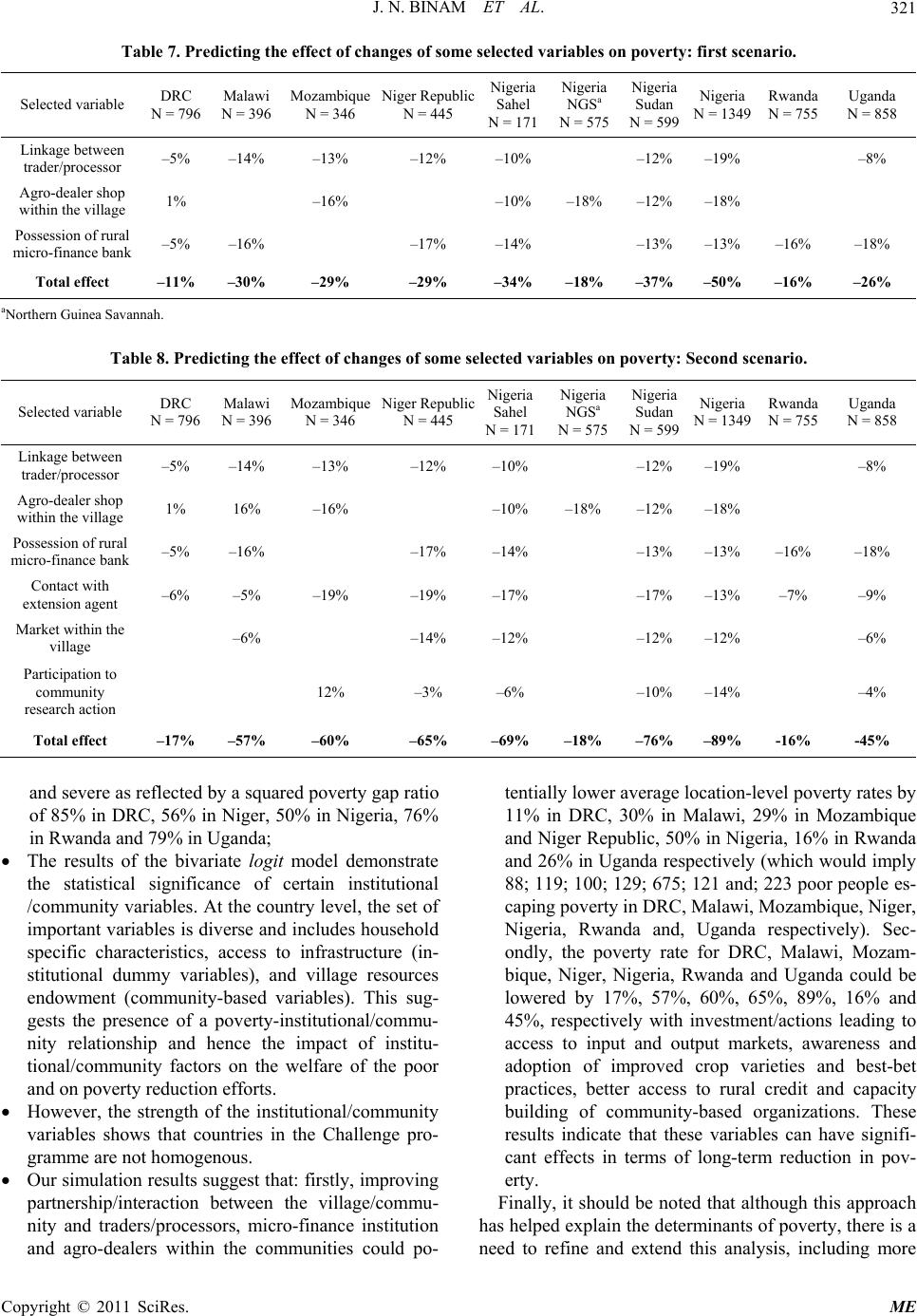 J. N. BINAM ET AL. Copyright © 2011 SciRes. ME 321 me ublic 5 Table 7. Predicting the effect of changes of so Selected variable DRC N = 796 Malawi N = 396 Mozambique N = 346 Niger Rep N = 44 selected variables on poverty: first scenario. Nigeria Sahel N = 171 Nigeria NGSa N = 575 Nigeria Sudan N = 599 Nigeria N = 1349 Rwanda N = 755 Uganda N = 858 Linkage between trader/processor –5% –14% –13% –12% –10% –12%–19% –8% Agro-dealer shop within the village 1% –16% Possession of rural micro-finance bank –5% –16% –17% Total effect –11% –30% –29% –29% –10% –18% –12%–18% –14% –13%–13% –16% –18% –34%–18% –37%–50% –16% –26% aNorthern Guinea Savannah. Table 8. Predicting the effect of changes of som Selected variable DRC N = 796 Malawi N = 396 Mozambique N = 346 Niger Repu N = 4 e se blic 45 lected variables on poverty: Second scenario. Nigeria Sahel N Nigeria NGSa Nigeria Sudan Nigeria N = 1349 Rwanda N = 755 Uganda N = 858 = 171N = 575N = 599 Linkage between trader/processor –5% –14% –13% –12% –10% –12%–19% –8% Agro-dealer shop within the village 1% 16% –16% Possession of rural micro-finance bank –5% –16% –17% Contact with extension agent –6% –5% –19% –19% Market within the village –6% –14% Participation to community research action 12% –3% –10% –18% –12%–18% –14% –13%–13% –16% –18% –17% –17%–13% –7% –9% –6% –12% –12%–12% –6% –10%–14% –4% –69%–18% –76%–89% -16% -45% Total effect –17% –57% –60% –65% and severe as reflected by a squared poverty gap ratio of 85% in DRC, 56% in Niger, 50% in Nigeria, 76% in Rwanda and 79% in Uganda; The results of the bivariate logit model demonstrate the statistical significance of certain institutional /community variables. At the country level, the set of % in Uganda respectively (which would imply important variables is diverse and includes household specific characteristics, access to infrastructure (in- stitutional dummy variables), and village resources endowment (community-based variables). This sug- gests the presence of a poverty-institutional/commu- nity relationship and hence the impact of institu- tional/community factors on the welfare of the poor and on poverty reduction efforts. However, the strength of the institutional/community variables shows that countries in the Challenge pro- gramme are not homogenous. Our simulation results suggest that: firstly, improving partnership/interaction between the village/commu- nity and traders/processors, micro-finance institution and agro-dealers within the communities could po- tentially lower average location-level poverty rates by 11% in DRC, 30% in Malawi, 29% in Mozambique and Niger Republic, 50% in Nigeria, 16% in Rwanda and 26 88; 119; 100; 129; 675; 121 and; 223 poor people es- caping poverty in DRC, Malawi, Mozambique, Niger, Nigeria, Rwanda and, Uganda respectively). Sec- ondly, the poverty rate for DRC, Malawi, Mozam- bique, Niger, Nigeria, Rwanda and Uganda could be lowered by 17%, 57%, 60%, 65%, 89%, 16% and 45%, respectively with investment/actions leading to access to input and output markets, awareness and adoption of improved crop varieties and best-bet practices, better access to rural credit and capacity building of community-based organizations. These results indicate that these variables can have signifi- cant effects in terms of long-term reduction in pov- erty. Finally, it should be noted that although this approach has helped explain the determinants of poverty, there is a need to refine and extend thi analysis, including more s 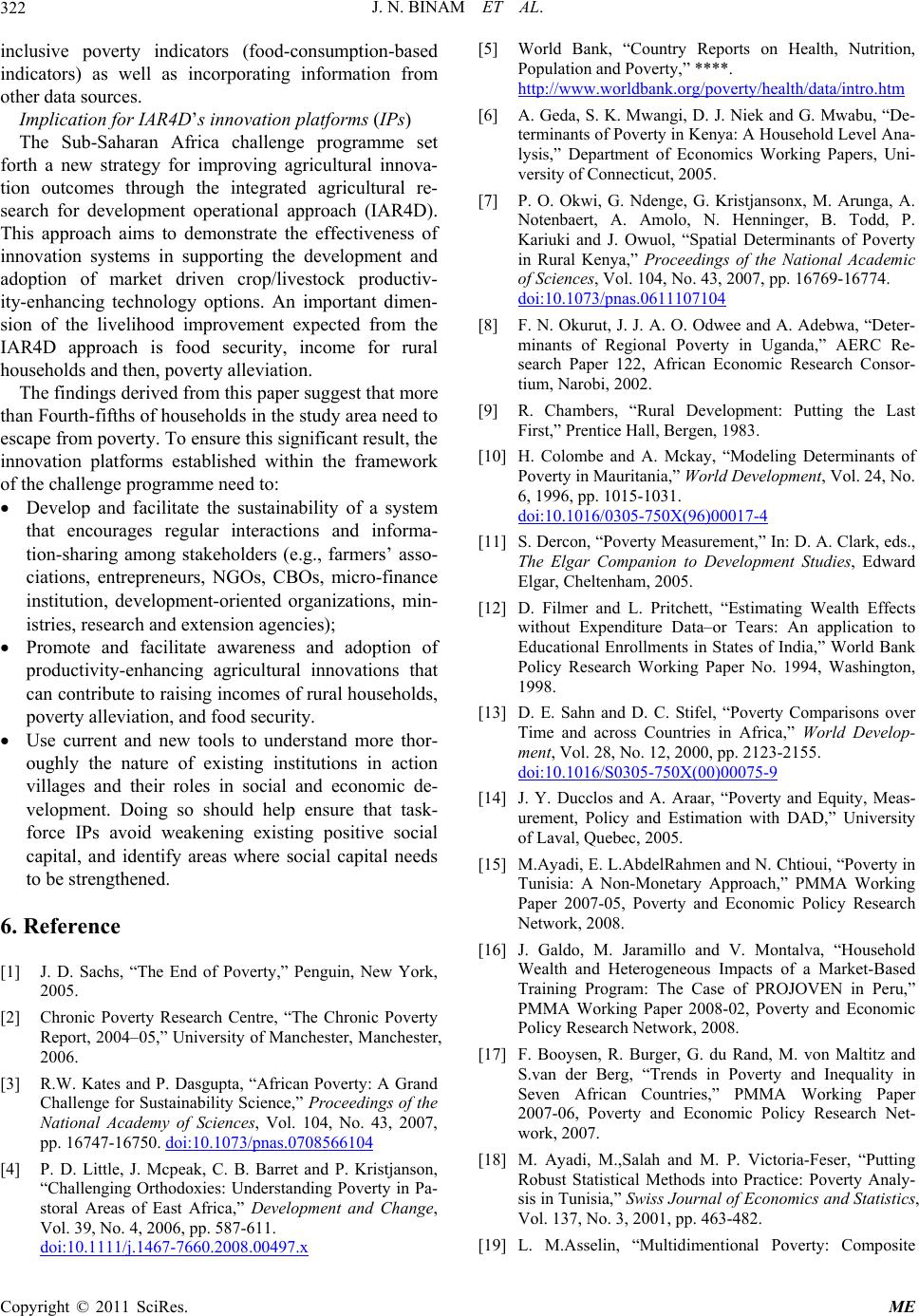 J. N. BINAM ET AL. 322 inclusive pove indicators) as well as incorporating information from ots. r Iin p (IPs Africa challenge programme set fotegyimpral inn tiorouthe in sepmoperational ap (IAR4D Ts toemonstrate the effectiveness of is in suppoe development and adoarkeen /live produ gy options. An important dimen- improvement expected from the R4D appro households an The findings deriveompe th oe escape from poverty. To ensure this significant result, the innovation platformbliew of the challenge programme need to: aci the sustainability of a syste interactions and informa- oake (e.g., rmers’ a preneurs, NGOs, CBOs, micro-finance evel nt-od orgions, m and extension agencies); Prand faciate aess anadoption nhancing agricultural innovations that cte to raising inces of rouseho iation, and food security. andoonderore t oughly the nature of existing institutions in action ting positive social can Poverty: A Grand rty indicators (food-consumption-based her data source Implication foAR4D’s nnovatiolatforms) The Sub-Saharan rth a new stra for roving agiculturova- n outcomes th arch for develo gh ent tegrated agricultural re- proach ). his approach aim nnovation system d rting th ption of mt driv cropstock ctiv- ity-enhancing technolo ion of the livelihoods IAach is food security, income for rural d then, poverty alleviation. d fr this par suggest that m a ore nean Fourth-fifthsf households in thstudy areed to s estashed within the framork Develop and flitatem that encourages regular tion-sharing amng stholdersfasso- ciations, entre institution, dopmeriente anizatin- istries, research omote lit warend of productivity-e an contribu poverty allev omural hlds, Use current new tls to ustand mhor- villages and their roles in social and economic de- velopment. Doing so should help ensure that task- force IPs avoid weakening exis capital, and identify areas where social capital needs to be strengthened. 6. Reference [1] J. D. Sachs, “The End of Poverty,” Penguin, New York, 2005. [2] Chronic Poverty Research Centre, “The Chronic Poverty Report, 2004–05,” University of Manchester, Manchester, 2006. [3] R.W. Kates and P. Dasgupta, “Afri Challenge for Sustainability Science,” Proceedings of the National Academy of Sciences, Vol. 104, No. 43, 2007, pp. 16747-16750. doi:10.1073/pnas.0708566104 [4] P. D. Little, J. Mcpeak, C. B. Barret and P. Kristjanson, “Challenging Orthodoxies: Understanding Poverty in Pa- storal Areas of East Africa,” Development and Change, Vol. 39, No. 4, 2006, pp. 587-611. doi:10.1111/j.1467-7660.2008.00497.x [5] World Bank, “Country Reports on Health, Nutrition, Population and Poverty,” ****. :/orrg / ta/http/www.w ldbank.o/poverty health/daintro.htm [. ,w- inants o Ponya: A Household Level Ana- DrtmeEconomics Working Papers, Uni- versity of Connecticut, 2005. [7 O. . e, Gjanso, M. Arunga, A. Notenbaert, A. Amolo, N. Henninger, B. Todd, P. riuki d J. Owuol, “Setts orty in Rural Kenya,” Proceedings of the National Academic Scieolo.7, 69-1 doi:10.1073/pnas.0611107104 6] A. G term eda, S. K f Mwangi verty in Ke D. J. Niek and G. Mabu, “De lysis,”epant of ] P. Okwi, GNdeng. Kristnx Ka anpatial Derminanf Pove of nces, V. 104, N 43, 200pp. 1676774. [8] F. N. Okurut, J. J. A. O. Odwee and A. Adebwa, “Deter- earch Consor- , 20 [Ch, Dengst st,e r [1 Colome andckaeterm of verty iW lopment, Vol. 24, No. 5-1031. i:10 30 minants of Regional Poverty in Uganda,” AERC Re- search Paper 122, African Economic Res tium 9] R. Narobi, ambers 02. “Rural evelopmnt: Putti the La Fir” PrenticHall, Be gen, 1983. 0] H. Po b n Maur A. M itania,” y, “Modeling D orld Deve inants 6, 1996, pp. 101 .1016/0do 5-750X(96)00017-4 [1 Derco “Poveast,” . Cls., e Elga Comp to pmdiesrd Elgar, Cheltenham, 2005. [12] er and L.ettating Wealth Effects thout xpendataears: n applic to ucational Enrts is of Inia,” Wonk Policy Research Working Paper No. 1994, Washington, 98. [13] D. E. Sahn and D. C. Stifel, “Poverty Comparisons over me rostrifricrld Develop- nt, Vol. 28, N00 doi:10.1016/S0305-750X(00)00075-9 1] S. Th n, r erty M anion uremen Develo In: D. A ent Stu ark, ed , Edwa D. Film Pritch, “Estim wi Ed Eiture D ollmen –or T n State A d ation rld Ba 19 Ti me and acs Coun o. 12, 2 es in A 0, pp. 2123-2155. a,” Wo ust Statistical Methods into Practice: Poverty Analy- [14] J. Y. Ducclos and A. Araar, “Poverty and Equity, Meas- urement, Policy and Estimation with DAD,” University of Laval, Quebec, 2005. [15] M.Ayadi, E. L.AbdelRahmen and N. Chtioui, “Poverty in Tunisia: A Non-Monetary Approach,” PMMA Working Paper 2007-05, Poverty and Economic Policy Research Network, 2008. [16] J. Galdo, M. Jaramillo and V. Montalva, “Household Wealth and Heterogeneous Impacts of a Market-Based Training Program: The Case of PROJOVEN in Peru,” PMMA Working Paper 2008-02, Poverty and Economic Policy Research Network, 2008. [17] F. Booysen, R. Burger, G. du Rand, M. von Maltitz and S.van der Berg, “Trends in Poverty and Inequality in Seven African Countries,” PMMA Working Paper 2007-06, Poverty and Economic Policy Research Net- work, 2007. [18] M. Ayadi, M.,Salah and M. P. Victoria-Feser, “Putting Rob sis in Tunisia,” Swiss Journal of Economics and Statistics, Vol. 137, No. 3, 2001, pp. 463-482. [19] L. M.Asselin, “Multidimentional Poverty: Composite Copyright © 2011 SciRes. ME 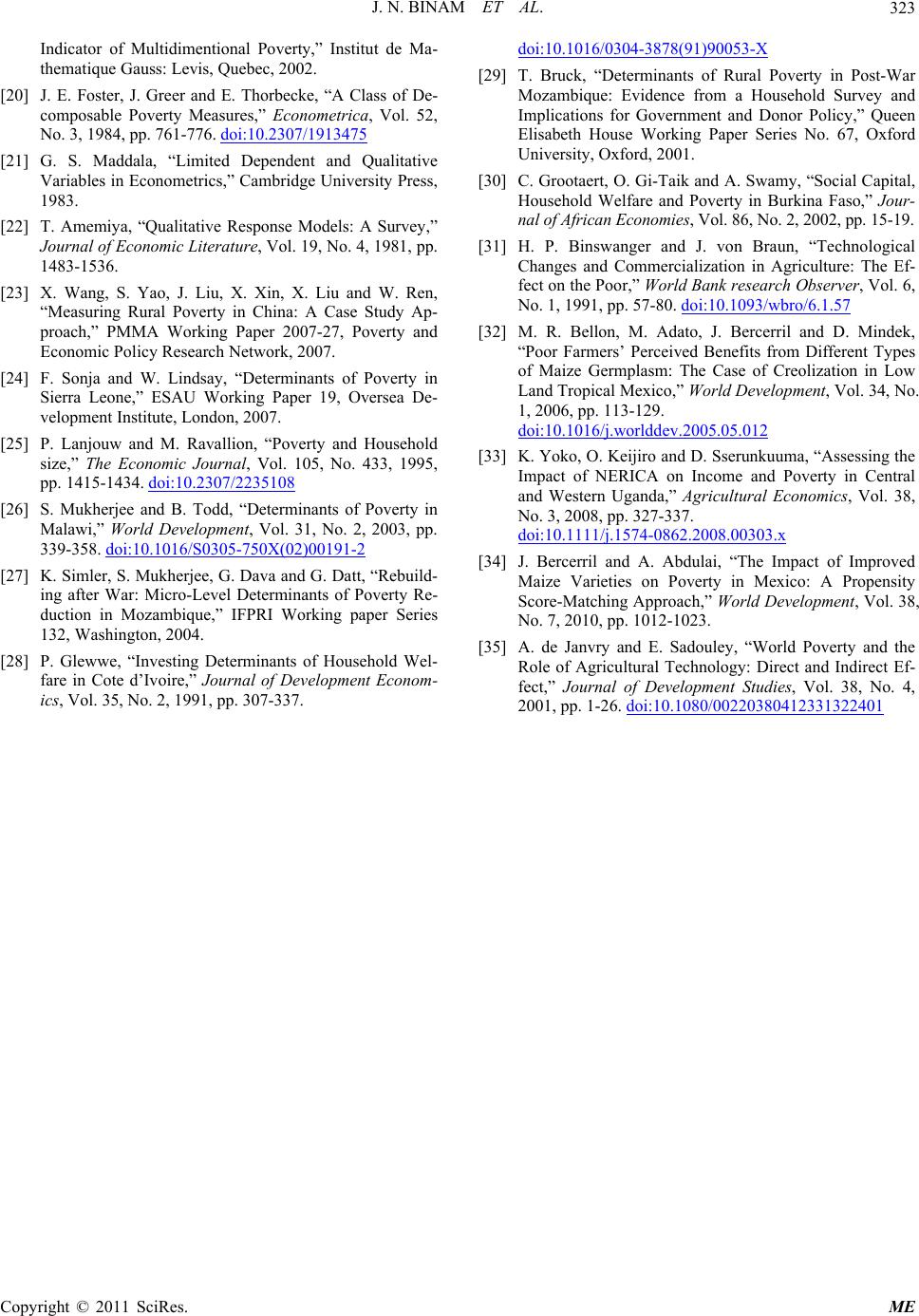 J. N. BINAM ET AL. Copyright © 2011 SciRes. ME 323 and E. Thorbecke, “A Class of De- Indicator of Multidimentional Poverty,” Institut de Ma- thematique Gauss: Levis, Quebec, 2002. [20] J. E. Foster, J. Greer composable Poverty Measures,” Econometrica, Vol. 52, No. 3, 1984, pp. 761-776. doi:10.2307/1913475 [21] G. S. Maddala, “Limited Dependent and Qualitative Variables in Econometrics,” Cambridge University Press, 1983. [22] T. Amemiya, “Qualitative Response Models: A Survey,” Journal of Economic Literature, Vol. 19, No. 4, 1981, pp. 1483-1536. [23] X. Wang, S. Yao, J. Liu, X. Xin, X. Liu and W. Ren, “Measuring Rural Poverty in China: A Case Study Ap- proach,” PMMA Working Paper 2007-27, Poverty and Economic Policy Research Network, 2007. [24] F. Sonja and W. Lindsay, “Determinants of Poverty in Sierra Leone,” ESAU Working Paper 19, Oversea De- velopment Institute, London, 2007. [25] P. Lanjouw and M. Ravallion, “Poverty and Household size,” The Economic Journal, Vol. 105, No. 433, 1995, pp. 1415-1434. doi:10.2307/2235108 [26] S. Mukherjee and B. Todd, “Determinants of Poverty in Malawi,” World Development, Vol. 31, No. 2, 2003, pp. 339-358. doi:10.1016/S0305-750X(02)00191-2 [27] K. Simler, S. Mukherjee, G. Dava and G. Datt, “Rebuild- ing after War: Micro-Level Determinants of Poverty Re- duction in Mozambique,” IFPRI Working paper Series 132, Washington, 2004. [28] P. Glewwe, “Investing Determinants of Household Wel- fare in Cote d’Ivoire,” Journal of Development Econom- ics, Vol. 35, No. 2, 1991, pp. 307-337. doi:10.1016/0304-3878(91)90053-X [29] T. Bruck, “Determinants of Rural Poverty in Post-War Mozambique: Evidence from a Household Survey and . Swamy, “Social Capital, , 093/wbro/6.1.57 Implications for Government and Donor Policy,” Queen Elisabeth House Working Paper Series No. 67, Oxford University, Oxford, 2001. [30] C. Grootaert, O. Gi-Taik and A Household Welfare and Poverty in Burkina Faso,” Jour- nal of African Economies, Vol. 86, No. 2, 2002, pp. 15-19. [31] H. P. Binswanger and J. von Braun, “Technological Changes and Commercialization in Agriculture: The Ef- fect on the Poor,” World Bank research Observer, Vol. 6 No. 1, 1991, pp. 57-80. doi:10.1 ,” World Development, Vol. 34, No. [32] M. R. Bellon, M. Adato, J. Bercerril and D. Mindek, “Poor Farmers’ Perceived Benefits from Different Types of Maize Germplasm: The Case of Creolization in Low Land Tropical Mexico 1, 2006, pp. 113-129. doi:10.1016/j.worlddev.2005.05.012 ricultural Economics, Vol. 38, [33] K. Yoko, O. Keijiro and D. Sserunkuuma, “Assessing the Impact of NERICA on Income and Poverty in Central and Western Uganda,” Ag No. 3, 2008, pp. 327-337. doi:10.1111/j.1574-0862.2008.00303.x [34] J. Bercerril and A. Abdulai, “The Impact of Improved Maize Varieties on Poverty in Mexico: A Propensity Journal of Development Studies, Vol. 38, No. 4, Score-Matching Approach,” World Development, Vol. 38, No. 7, 2010, pp. 1012-1023. [35] A. de Janvry and E. Sadouley, “World Poverty and the Role of Agricultural Technology: Direct and Indirect Ef- fect,” 2001, pp. 1-26. doi:10.1080/00220380412331322401
|